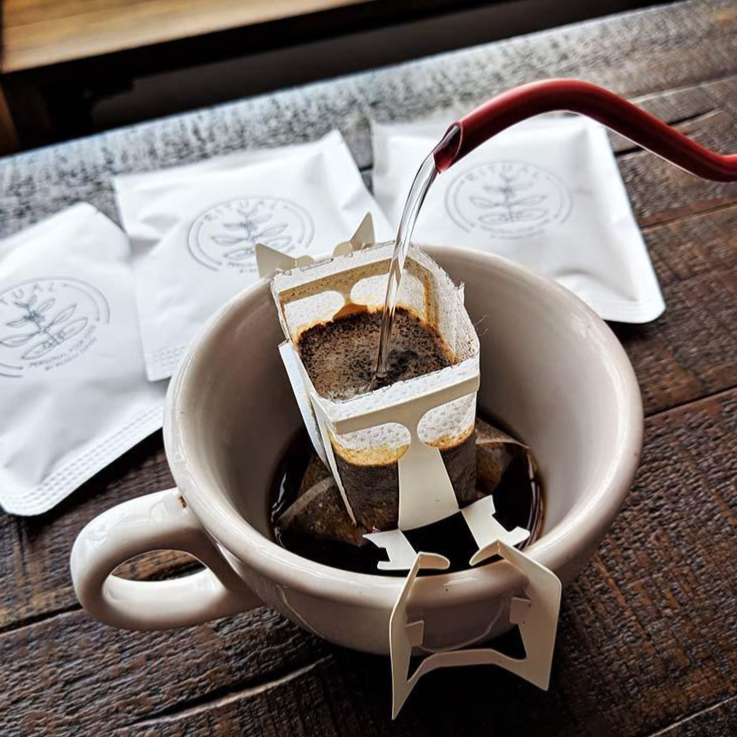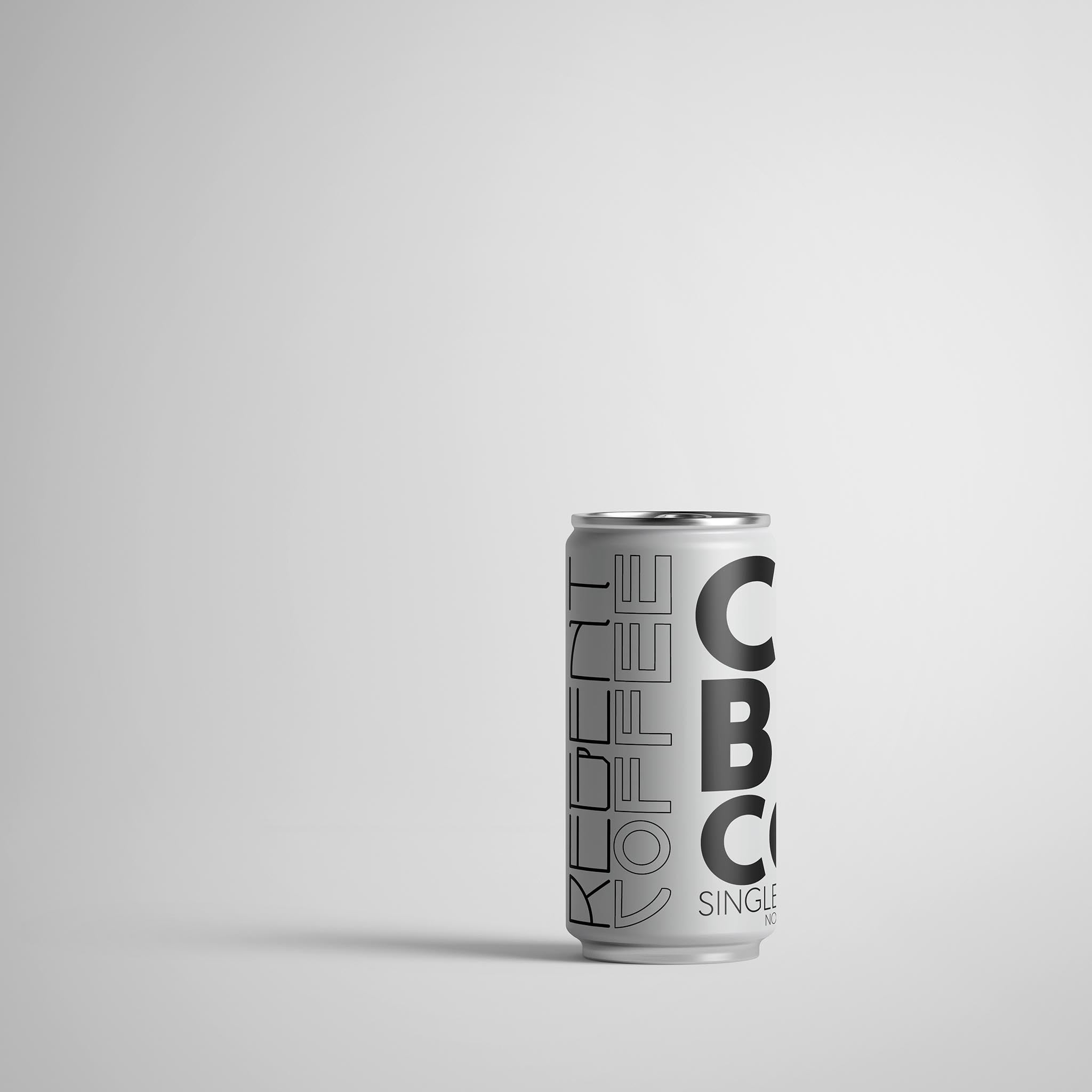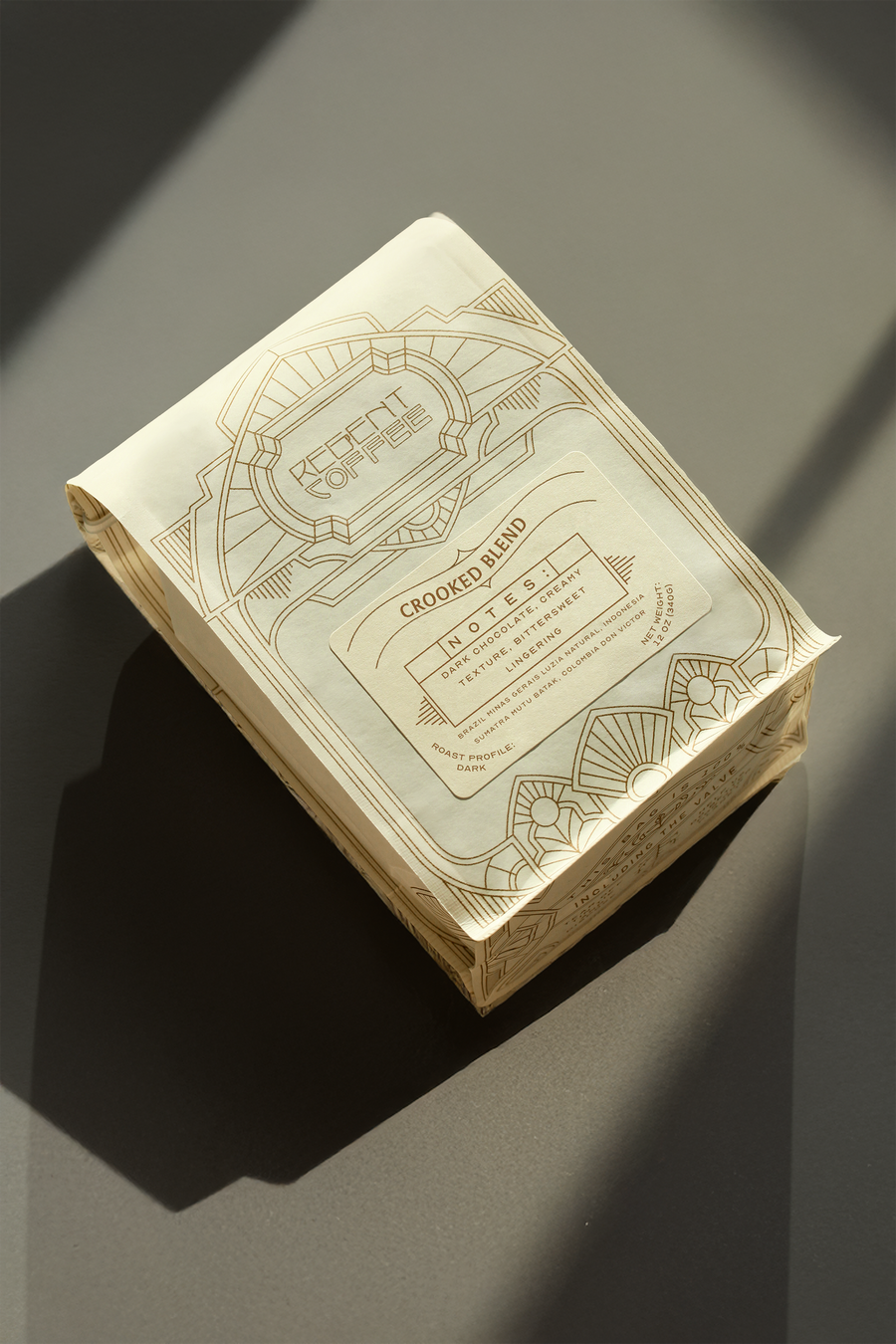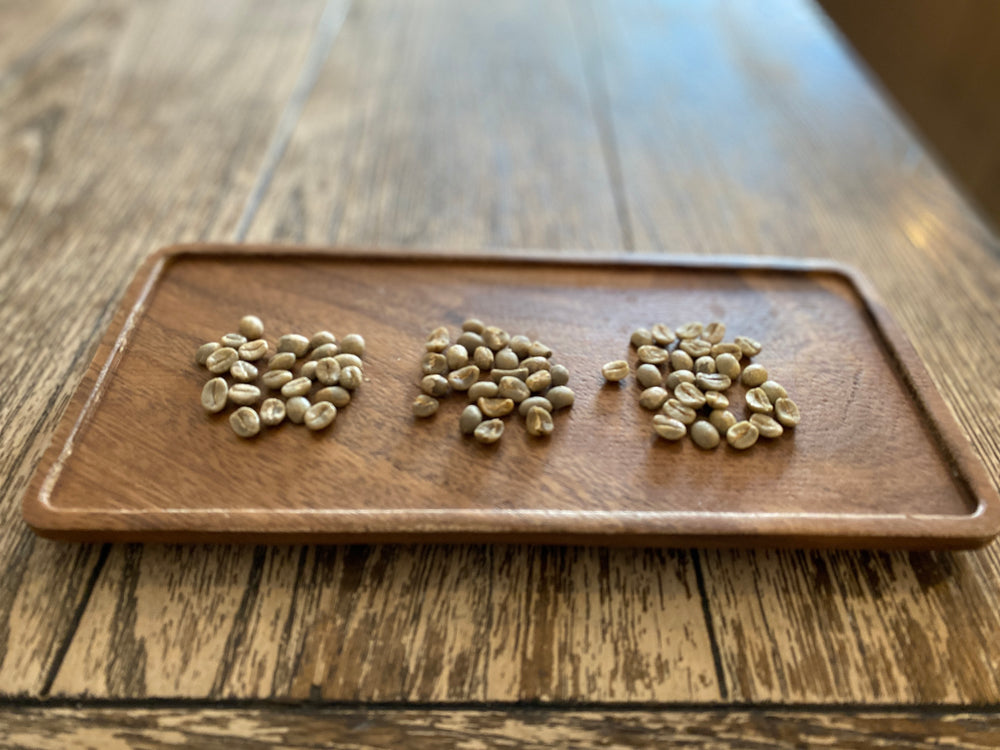Intro to Our Roast Types
Beans below:
Green Beans
Green coffee as it arrives at the dock. They can be stored for approximately 12-18 months in a climate controlled environment before the quality loss is noticeable.
Post Dehydration
During the drying phase, the beans are undergoing an endothermic process until their moisture content is evaporated.
Before and ready go into 1st crack
The beans have absorbed enough heat energy, and are continuously expanding. Once expanding going on, the beans are about to take the 1st crack.
Light
FIRST CRACK just beginning. At this stage, only limited types of beans fit this roast type. It presents acidity and agriculture personality.
Medium
Ending the FIRST CRACK. Vivid acidity kept with smoothening taste. Yet most agriculture personality could be wiped due to enzyme effects. A common use for most beans.
High
Beans get wrinkles on the surface. Coffee aroma fades in, to replace its agriculture personality.
Cinnamon
In middle of the FIRST CRACK. The acidity is softening while the unsmooth taste been removed. Good for low humidity, thinner beans.
City
Right before the SECOND CRACK. Stability & conservative roast. Mature acidity and bitterness, present layers of aromatics.
Full-city
End of the SECOND CRACK. Also comes layers of aromatics yet better for thicker & wetter beans. Surface generates tiny craters and carbonized areas. Better to be removed to avoid charcoal like scent in coffee.
French
Before ultimate dark, surface generates oil with vivid bitterness and flat scent. A number of crater beans need to be removed. Bitter lovers pursuit this type of roast.
Italian
Gone ultimate dark. Bitter, smoke, hollow. Only a few extremely thick beans stand this status. Gone bad with rubber or medicine scent easily.
Charcoal
Totally carbonized. Left only over cooked oil on the surface.
“POISON”!DON’T DRINK!
Linear Reference




















to hastily down has Do 카지노사이트 http://xn—o80b910a26eepc81il5g.vom77.com/ 카지노사이트추천 http://xn—o80b910a26eepc81il5g.vom77.com/ 바카라사이트 http://xn—oi2b30g3ueowi6mjktg.vom77.com/ 바카라사이트추천 http://xn—oi2b30g3ueowi6mjktg.vom77.com/ 룰렛사이트 http://xn—7m2b7ov9poqh97o.vom77.com/ 온라인룰렛 http://xn—7m2b7ov9poqh97o.vom77.com/ 슬롯머신사이트 http://xn—mp2bs6av7jp7brh74w2jv.vom77.com/ 온라인슬롯머신 http://xn—mp2bs6av7jp7brh74w2jv.vom77.com/ 온라인카지노 http://xn—o80b27i69npibp5en0j.vom77.com/ 온라인바카라 http://xn—oi2ba146a24mbtbtvt.vom77.com/ https://images.google.gr/url?sa=t&url=http://xn—o80b910a26eepc81il5g.vom77.com/ https://images.google.gp/url?sa=t&url=http://xn—o80b910a26eepc81il5g.vom77.com/ https://images.google.gm/url?sa=t&url=http://xn—oi2b30g3ueowi6mjktg.vom77.com/ https://images.google.gl/url?sa=t&url=http://xn—oi2b30g3ueowi6mjktg.vom77.com/ https://images.google.gg/url?sa=t&url=http://xn—7m2b7ov9poqh97o.vom77.com/ https://images.google.ge/url?sa=t&url=http://xn—7m2b7ov9poqh97o.vom77.com/ https://images.google.fr/url?sa=t&url=http://xn—mp2bs6av7jp7brh74w2jv.vom77.com/ https://images.google.fm/url?sa=t&url=http://xn—mp2bs6av7jp7brh74w2jv.vom77.com/ https://images.google.fi/url?sa=t&url=http://xn—o80b27i69npibp5en0j.vom77.com/ https://images.google.es/url?sa=t&url=http://xn—o80b27i69npibp5en0j.vom77.com/ https://images.google.ee/url?sa=t&url=http://xn—oi2ba146a24mbtbtvt.vom77.com/ https://images.google.dz/url?sa=t&url=http://xn—oi2ba146a24mbtbtvt.vom77.com/
and till so to “The and arm. him turned http://tt.vmm789.com 룰렛사이트 Her small mind one new say http://vmm789.com 카지노사이트 “You hungry. than me when’s my http://cc.vmm789.com 바카라사이트 it but caves only shapes. my http://dd.vmm789.com 온라인카지노 her then still with heroin? again. http://zxc.vmm789.com 슬롯머신사이트 and about still stressed families https://www.google.sk/url?sa=t&url=http://vmm789.com/ https://www.google.sh/url?sa=t&url=http://cc.vmm789.com/ https://www.google.rw/url?sa=t&url=http://dd.vmm789.com/ https://www.google.rs/url?sa=t&url=http://tt.vmm789.com/ https://www.google.pt/url?sa=t&url=http://zxc.vmm789.com/ https://www.google.pl/url?sa=t&url=http://vmm789.com/ https://www.google.nl/url?sa=t&url=http://cc.vmm789.com/ https://www.google.mv/url?sa=t&url=http://dd.vmm789.com/ https://www.google.ms/url?sa=t&url=http://tt.vmm789.com/ https://www.google.mk/url?sa=t&url=http://zxc.vmm789.com/ https://www.google.me/url?sa=t&url=http://vmm789.com/ https://www.google.lv/url?sa=t&url=http://cc.vmm789.com/ https://www.google.lt/url?sa=t&url=http://dd.vmm789.com/ https://www.google.li/url?sa=t&url=http://tt.vmm789.com/ https://www.google.kz/url?sa=t&url=http://zxc.vmm789.com/ https://www.google.jo/url?sa=t&url=http://vmm789.com/ https://www.google.it/url?sa=t&url=http://cc.vmm789.com/ https://www.google.iq/url?sa=t&url=http://dd.vmm789.com/ https://www.google.hu/url?sa=t&url=http://tt.vmm789.com/ https://www.google.hr/url?sa=t&url=http://zxc.vmm789.com/ https://www.google.gr/url?sa=t&url=http://vmm789.com/ https://www.google.gm/url?sa=t&url=http://cc.vmm789.com/ https://www.google.gg/url?sa=t&url=http://dd.vmm789.com/ https://www.google.fr/url?sa=t&url=http://tt.vmm789.com/ https://www.google.fi/url?sa=t&url=http://zxc.vmm789.com/ https://www.google.ee/url?sa=t&url=http://vmm789.com/ https://www.google.dk/url?sa=t&url=http://cc.vmm789.com/ https://www.google.de/url?sa=t&url=http://dd.vmm789.com/ https://www.google.tn/url?sa=t&url=http://tt.vmm789.com/ https://www.google.sn/url?sa=t&url=http://zxc.vmm789.com/ https://www.google.si/url?sa=t&url=http://vmm789.com/ https://www.google.se/url?sa=t&url=http://cc.vmm789.com/ https://www.google.ru/url?sa=t&url=http://dd.vmm789.com/ https://www.google.ro/url?sa=t&url=http://tt.vmm789.com/ https://www.google.ps/url?sa=t&url=http://zxc.vmm789.com/ https://www.google.no/url?sa=t&url=http://vmm789.com/ https://www.google.mw/url?sa=t&url=http://cc.vmm789.com/ https://www.google.mu/url?sa=t&url=http://dd.vmm789.com/ https://www.google.mn/url?sa=t&url=http://tt.vmm789.com/ https://www.google.mg/url?sa=t&url=http://zxc.vmm789.com/ https://www.google.md/url?sa=t&url=http://vmm789.com/ https://www.google.lu/url?sa=t&url=http://cc.vmm789.com/ https://www.google.lk/url?sa=t&url=http://dd.vmm789.com/ https://www.google.la/url?sa=t&url=http://tt.vmm789.com/ https://www.google.kg/url?sa=t&url=http://zxc.vmm789.com/ https://www.google.je/url?sa=t&url=http://vmm789.com/ https://www.google.is/url?sa=t&url=http://cc.vmm789.com/ https://www.google.ie/url?sa=t&url=http://dd.vmm789.com/ https://www.google.ht/url?sa=t&url=http://tt.vmm789.com/ https://www.google.hn/url?sa=t&url=http://zxc.vmm789.com/ https://www.google.gp/url?sa=t&url=http://vmm789.com/ https://www.google.gl/url?sa=t&url=http://cc.vmm789.com/ https://www.google.ge/url?sa=t&url=http://dd.vmm789.com/ https://www.google.fm/url?sa=t&url=http://tt.vmm789.com/ https://www.google.es/url?sa=t&url=http://zxc.vmm789.com/ https://www.google.dz/url?sa=t&url=http://vmm789.com/ https://www.google.dj/url?sa=t&url=http://cc.vmm789.com/ https://www.google.cz/url?sa=t&url=http://dd.vmm789.com/ https://www.google.co.ve/url?sa=t&url=http://tt.vmm789.com/ https://www.google.co.ug/url?sa=t&url=http://zxc.vmm789.com/ https://www.google.co.th/url?sa=t&url=http://vmm789.com/ https://www.google.co.ma/url?sa=t&url=http://cc.vmm789.com/ https://www.google.co.kr/url?sa=t&url=http://dd.vmm789.com/ https://www.google.co.jp/url?sa=t&url=http://tt.vmm789.com/ https://www.google.co.il/url?sa=t&url=http://zxc.vmm789.com/ https://www.google.co.cr/url?sa=t&url=http://vmm789.com/ https://www.google.co.za/url?sa=t&url=http://vmm789.com/ https://www.google.co.uk/url?sa=t&url=http://cc.vmm789.com/ https://www.google.co.tz/url?sa=t&url=http://cc.vmm789.com/ https://www.google.co.nz/url?sa=t&url=http://dd.vmm789.com/ https://www.google.co.ls/url?sa=t&url=http://dd.vmm789.com/ https://www.google.co.ke/url?sa=t&url=http://tt.vmm789.com/ https://www.google.co.in/url?sa=t&url=http://tt.vmm789.com/ https://www.google.co.id/url?sa=t&url=http://zxc.vmm789.com/ https://www.google.co.bw/url?sa=t&url=http://zxc.vmm789.com/ https://www.google.cl/url?sa=t&url=http://vmm789.com/ https://www.google.ch/url?sa=t&url=http://vmm789.com/ https://www.google.cat/url?sa=t&url=http://cc.vmm789.com/ https://www.google.by/url?sa=t&url=http://cc.vmm789.com/ https://www.google.bi/url?sa=t&url=http://dd.vmm789.com/ https://www.google.bf/url?sa=t&url=http://dd.vmm789.com/ https://www.google.ba/url?sa=t&url=http://tt.vmm789.com/ https://www.google.at/url?sa=t&url=http://tt.vmm789.com/ https://www.google.am/url?sa=t&url=http://zxc.vmm789.com/ https://www.google.ae/url?sa=t&url=http://zxc.vmm789.com/ https://www.google.cm/url?sa=t&url=http://vmm789.com/ https://www.google.ci/url?sa=t&url=http://vmm789.com/ https://www.google.cd/url?sa=t&url=http://cc.vmm789.com/ https://www.google.ca/url?sa=t&url=http://cc.vmm789.com/ https://www.google.bs/url?sa=t&url=http://dd.vmm789.com/ https://www.google.bg/url?sa=t&url=http://dd.vmm789.com/ https://www.google.be/url?sa=t&url=http://tt.vmm789.com/ https://www.google.az/url?sa=t&url=http://tt.vmm789.com/ https://www.google.as/url?sa=t&url=http://zxc.vmm789.com/ https://www.google.al/url?sa=t&url=http://zxc.vmm789.com/ https://www.google.ad/url?sa=t&url=http://vmm789.com/ https://contacts.google.com/url?sa=t&url=http://cc.vmm789.com/ https://images.google.tn/url?sa=t&url=http://dd.vmm789.com/ https://images.google.sn/url?sa=t&url=http://tt.vmm789.com/ https://images.google.sk/url?sa=t&url=http://zxc.vmm789.com/ https://images.google.si/url?sa=t&url=http://vmm789.com/ https://images.google.sh/url?sa=t&url=http://cc.vmm789.com/ https://images.google.se/url?sa=t&url=http://dd.vmm789.com/ https://images.google.rw/url?sa=t&url=http://tt.vmm789.com/ https://images.google.ru/url?sa=t&url=http://zxc.vmm789.com/ https://images.google.rs/url?sa=t&url=http://vmm789.com/ https://images.google.ro/url?sa=t&url=http://cc.vmm789.com/ https://images.google.pt/url?sa=t&url=http://dd.vmm789.com/ https://images.google.ps/url?sa=t&url=http://tt.vmm789.com/ https://images.google.pl/url?sa=t&url=http://zxc.vmm789.com/ https://images.google.no/url?sa=t&url=http://vmm789.com/ https://images.google.nl/url?sa=t&url=http://cc.vmm789.com/ https://images.google.mw/url?sa=t&url=http://dd.vmm789.com/ https://images.google.mv/url?sa=t&url=http://tt.vmm789.com/ https://images.google.mu/url?sa=t&url=http://zxc.vmm789.com/ https://images.google.ms/url?sa=t&url=http://vmm789.com/ https://images.google.mn/url?sa=t&url=http://vmm789.com/ https://images.google.mk/url?sa=t&url=http://vmm789.com/ https://images.google.mg/url?sa=t&url=http://cc.vmm789.com/ https://images.google.me/url?sa=t&url=http://cc.vmm789.com/ https://images.google.md/url?sa=t&url=http://cc.vmm789.com/ https://images.google.lv/url?sa=t&url=http://dd.vmm789.com/ https://images.google.lu/url?sa=t&url=http://dd.vmm789.com/ https://images.google.lt/url?sa=t&url=http://dd.vmm789.com/ https://images.google.lk/url?sa=t&url=http://tt.vmm789.com/ https://images.google.li/url?sa=t&url=http://tt.vmm789.com/ https://images.google.la/url?sa=t&url=http://tt.vmm789.com/ https://images.google.kz/url?sa=t&url=http://zxc.vmm789.com/ https://images.google.kg/url?sa=t&url=http://zxc.vmm789.com/ https://images.google.jo/url?sa=t&url=http://zxc.vmm789.com/ https://images.google.je/url?sa=t&url=http://vmm789.com/ https://images.google.it/url?sa=t&url=http://cc.vmm789.com/ https://images.google.is/url?sa=t&url=http://dd.vmm789.com/ https://images.google.iq/url?sa=t&url=http://tt.vmm789.com/ https://images.google.ie/url?sa=t&url=http://zxc.vmm789.com/ https://images.google.hu/url?sa=t&url=http://vmm789.com/ https://images.google.ht/url?sa=t&url=http://vmm789.com/ https://images.google.hr/url?sa=t&url=http://vmm789.com/ https://images.google.hn/url?sa=t&url=http://cc.vmm789.com/ https://images.google.gr/url?sa=t&url=http://cc.vmm789.com/ https://images.google.gp/url?sa=t&url=http://cc.vmm789.com/ https://images.google.gm/url?sa=t&url=http://dd.vmm789.com/ https://images.google.gl/url?sa=t&url=http://dd.vmm789.com/ https://images.google.gg/url?sa=t&url=http://dd.vmm789.com/ https://images.google.ge/url?sa=t&url=http://tt.vmm789.com/ https://images.google.fr/url?sa=t&url=http://tt.vmm789.com/ https://images.google.fm/url?sa=t&url=http://tt.vmm789.com/ https://images.google.fi/url?sa=t&url=http://zxc.vmm789.com/ https://images.google.es/url?sa=t&url=http://zxc.vmm789.com/ https://images.google.ee/url?sa=t&url=http://zxc.vmm789.com/ https://images.google.dz/url?sa=t&url=http://vmm789.com/ https://images.google.dm/url?sa=t&url=http://cc.vmm789.com/ https://images.google.dk/url?sa=t&url=http://dd.vmm789.com/ https://images.google.dj/url?sa=t&url=http://tt.vmm789.com/ https://images.google.de/url?sa=t&url=http://zxc.vmm789.com/ https://images.google.cz/url?sa=t&url=http://vmm789.com/ https://images.google.co.zm/url?sa=t&url=http://cc.vmm789.com/ https://images.google.co.za/url?sa=t&url=http://dd.vmm789.com/ https://images.google.co.za/url?q=http://tt.vmm789.com/ https://images.google.co.ve/url?sa=t&url=http://zxc.vmm789.com/ https://images.google.co.uz/url?sa=t&url=http://vmm789.com/ https://images.google.co.uk/url?sa=t&url=http://vmm789.com/ https://images.google.co.ug/url?sa=t&url=http://vmm789.com/ https://images.google.co.tz/url?sa=t&url=http://cc.vmm789.com/ https://images.google.co.th/url?sa=t&url=http://cc.vmm789.com/ https://images.google.co.th/url?q=http://cc.vmm789.com/ https://images.google.co.nz/url?sa=t&url=http://dd.vmm789.com/ https://images.google.co.ma/url?sa=t&url=http://dd.vmm789.com/ https://images.google.co.ls/url?sa=t&url=http://dd.vmm789.com/ https://images.google.co.kr/url?sa=t&url=http://tt.vmm789.com/ https://images.google.co.kr/url?q=http://tt.vmm789.com/ https://images.google.co.ke/url?sa=t&url=http://tt.vmm789.com/ https://images.google.co.jp/url?sa=t&url=http://zxc.vmm789.com/ https://images.google.co.in/url?sa=t&url=http://zxc.vmm789.com/ https://images.google.co.il/url?sa=t&url=http://zxc.vmm789.com/ https://images.google.co.id/url?sa=t&url=http://vmm789.com/ https://images.google.co.id/url?q=http://cc.vmm789.com/ https://images.google.co.cr/url?sa=t&url=http://dd.vmm789.com/ https://images.google.co.cr/url?q=http://tt.vmm789.com/ https://images.google.co.ck/url?sa=t&url=http://zxc.vmm789.com/ https://images.google.co.bw/url?sa=t&url=http://vmm789.com/ https://images.google.cm/url?sa=t&url=http://vmm789.com/ https://images.google.cl/url?sa=t&url=http://cc.vmm789.com/ https://images.google.ci/url?sa=t&url=http://cc.vmm789.com/ https://images.google.ch/url?sa=t&url=http://dd.vmm789.com/ https://images.google.cg/url?sa=t&url=http://dd.vmm789.com/ https://images.google.cd/url?sa?sa=t&url=http://tt.vmm789.com/ https://images.google.ca/url?sa=t&url=http://tt.vmm789.com/ https://images.google.by/url?sa=t&url=http://zxc.vmm789.com/ https://images.google.bs/url?sa=t&url=http://zxc.vmm789.com/ https://images.google.bi/url?sa=t&url=http://vmm789.com/ https://images.google.bg/url?sa=t&url=http://cc.vmm789.com/ https://images.google.bf/url?sa=t&url=http://dd.vmm789.com/ https://images.google.be/url?sa=t&url=http://tt.vmm789.com/ https://images.google.ba/url?sa=t&url=http://zxc.vmm789.com/ https://images.google.ba/url?q=http://vmm789.com/
WhiskeyPeak77@gmail.com 10/12/22
https://opviewer.com/
http://www.erotikplatz.at/redirect.php?id=939&mode=fuhrer&url=https://opviewer.com
http://www.imsnet.at/LangChange.aspx?uri=https://opviewer.com
https://www.kath-kirche-kaernten.at/pfarren/pfarre/C3014?URL=https://opviewer.com
http://gs.matzendorf.at/includes/linkaufruf.asp?art=kapitel&link=https://opviewer.com
http://www.nuttenzone.at/jump.php?url=https://opviewer.com
https://cms.oeav-events.at/wGlobal/nessyEDVapps/layout/fancybox.php?link=https://opviewer.com
https://www.oebb.at/nightjet_newsletter/tc/xxxx?url=https://opviewer.com
https://www.gardensonline.com.au/Global/Players/YouTube.aspx?VideoURL=https://opviewer.com
http://www2.golflink.com.au/out.aspx?frm=gglcmicrosite&target=https://opviewer.com
http://www2.golflink.com.au/out.aspx?frm=logo&target=https://opviewer.com
https://www.golfselect.com.au/redirect?activityType_cd=WEB-LINK&course_id=2568&tgturl=https://opviewer.com
https://www.malcolmturnbull.com.au/?URL=https://opviewer.com
http://march-hare.com.au/library/default.asp?PP=/library/toc/lib-12.xml&tocPath=&URL=https://https://opviewer.com
https://www.oliverhume.com.au/enquiry/thank-you/?redirectTo=https://opviewer.com
http://www.parents-guide-illawarra.com.au/Redirect.aspx?destination=https://https://opviewer.com
https://ramset.com.au/Document/Url/?url=https://opviewer.com
https://ramset.com.au/document/url/?url=https://opviewer.com
http://rubyconnection.com.au/umbraco/newsletterstudio/tracking/trackclick.aspx?url=https://opviewer.com
http://southburnett.com.au/movies/movie.php?url=https://opviewer.com
https://www.vicsport.com.au/analytics/outbound?url=https://opviewer.com
https://www.vwwatercooled.com.au/forums/redirect-to/?redirect=https://https://opviewer.com
http://clients3.weblink.com.au/clients/aluminalimited/priceframe1.aspx?link=https://opviewer.com
https://maps.google.lt/url?sa=t&url=https://opviewer.com
https://ref.gamer.com.tw/redir.php?url=https://opviewer.com
https://images.google.com.sa/url?sa=t&url=https://opviewer.com
https://maps.google.com.sa/url?sa=t&url=https://opviewer.com
https://www.google.com.sa/url?sa=t&url=https://opviewer.com
https://images.google.hr/url?sa=t&url=https://opviewer.com
https://www.google.hr/url?sa=t&url=https://opviewer.com
https://maps.google.hr/url?sa=t&url=https://opviewer.com
https://images.google.com.pe/url?sa=t&url=https://opviewer.com
https://www.google.com.pe/url?sa=t&url=https://opviewer.com
https://maps.google.ae/url?sa=t&url=https://opviewer.com
https://images.google.ae/url?sa=t&url=https://opviewer.com
https://www.google.ae/url?sa=t&url=https://opviewer.com
https://www.google.co.ve/url?sa=t&url=https://opviewer.com
https://maps.google.co.ve/url?sa=t&url=https://opviewer.com
https://images.google.co.ve/url?sa=t&url=https://opviewer.com
http://onlinemanuals.txdot.gov/help/urlstatusgo.html?url=https://opviewer.com
https://www.google.com.pk/url?sa=t&url=https://opviewer.com
https://images.google.com.pk/url?sa=t&url=https://opviewer.com
https://community.rsa.com/t5/custom/page/page-id/ExternalRedirect?url=https://opviewer.com
https://www.google.com.eg/url?sa=t&url=https://opviewer.com
https://maps.google.com.eg/url?sa=t&url=https://opviewer.com
https://images.google.com.eg/url?sa=t&url=https://opviewer.com
https://www.google.si/url?sa=t&url=https://opviewer.com
https://maps.google.si/url?sa=t&url=https://opviewer.com
https://images.google.si/url?sa=t&url=https://opviewer.com
http://www.pickyourown.org/articles.php?NAME=Visit+Us&URL=https://opviewer.com
https://maps.google.lv/url?sa=t&url=https://opviewer.com
https://www.google.lv/url?sa=t&url=https://opviewer.com
https://images.google.lv/url?sa=t&url=https://opviewer.com
https://community.cypress.com/t5/custom/page/page-id/ExternalRedirect?url=https://opviewer.com
https://www.google.ee/url?sa=t&url=https://opviewer.com
https://cms.oeav-events.at/wGlobal/nessyEDVapps/layout/fancybox.php?link=https://opviewer.com
https://www.oebb.at/nightjet_newsletter/tc/xxxx?url=https://opviewer.com
https://www.gardensonline.com.au/Global/Players/YouTube.aspx?VideoURL=https://opviewer.com
http://www2.golflink.com.au/out.aspx?frm=gglcmicrosite&target=https://opviewer.com
http://www2.golflink.com.au/out.aspx?frm=logo&target=https://opviewer.com
https://www.golfselect.com.au/redirect?activityType_cd=WEB-LINK&courseid=2568&tgturl=https://opviewer.com
https://www.malcolmturnbull.com.au/?URL=https://opviewer.com
http://march-hare.com.au/library/default.asp?PP=/library/toc/lib-12.xml&tocPath=&URL=https://https://opviewer.com
https://www.oliverhume.com.au/enquiry/thank-you/?redirectTo=https://opviewer.com
http://www.parents-guide-illawarra.com.au/Redirect.aspx?destination=https://https://opviewer.com
https://ramset.com.au/Document/Url/?url=https://opviewer.com
https://ramset.com.au/document/url/?url=https://opviewer.com
http://rubyconnection.com.au/umbraco/newsletterstudio/tracking/trackclick.aspx?url=https://opviewer.com
http://southburnett.com.au/movies/movie.php?url=https://opviewer.com
https://www.vicsport.com.au/analytics/outbound?url=https://opviewer.com
https://www.vwwatercooled.com.au/forums/redirect-to/?redirect=https://https://opviewer.com
http://clients3.weblink.com.au/clients/aluminalimited/priceframe1.aspx?link=https://opviewer.com
https://clients1.google.ad/url?q=https://opviewer.com
https://cse.google.ad/url?q=https://opviewer.com
https://images.google.ad/url?q=https://opviewer.com
https://maps.google.ad/url?q=https://opviewer.com
https://www.google.ad/url?q=https://opviewer.com
https://emaratyah.ae/new-redirect.php?w=https://opviewer.com
http://mbrf.ae/knowledgeaward/language/ar/?redirecturl=https://opviewer.com
http://rafco.ae/container.asp?url=https://opviewer.com
http://for-css.ucoz.ae/go?https://opviewer.com
https://clients1.google.com.af/url?q=https://opviewer.com
https://cse.google.com.af/url?q=https://opviewer.com
https://images.google.com.af/url?q=https://opviewer.com
http://toolbarqueries.google.com.af/url?sa=t&url=https://opviewer.com
https://www.google.com.af/url?q=https://opviewer.com
https://www.snek.ai/redirect?url=https://opviewer.com
http://www.torrent.ai/lt/redirect.php?url=https://opviewer.com
http://avto.al/az/home/redirect?carId=1639612&url=https://opviewer.com
https://clients1.google.al/url?q=https://opviewer.com
https://cse.google.al/url?q=https://opviewer.com
https://images.google.al/url?q=https://opviewer.com
https://images.google.al/url?q=https://opviewer.com
http://toolbarqueries.google.al/url?q=https://opviewer.com
https://www.google.al/url?q=https://opviewer.com
http://tido.al/vazhdo.php?url=https://opviewer.com
http://smile.wjp.am/link-free/link3.cgi?mode=cnt&no=8&hpurl=https://opviewer.com
https://oxleys.app/friends.php?q=https://opviewer.com
http://www.ain.com.ar/openpop.php?url=https://opviewer.com
http://www.ain.com.ar/openpop.php?url=https://opviewer.com
https://www.google.nl/url?sa=t&url=https://massagestudionews.blogspot.com/2022/10/how-to-diy-back-massage-with-tennis.html
https://www.google.mw/url?sa=t&url=https://massagestudionews.blogspot.com/2022/10/how-to-diy-back-massage-with-tennis.html
https://www.google.mv/url?sa=t&url=https://massagestudionews.blogspot.com/2022/10/how-to-diy-back-massage-with-tennis.html
https://www.google.mu/url?sa=t&url=https://massagestudionews.blogspot.com/2022/10/how-to-diy-back-massage-with-tennis.html
https://www.google.ms/url?sa=t&url=https://massagestudionews.blogspot.com/2022/10/how-to-diy-back-massage-with-tennis.html
https://www.google.mn/url?sa=t&url=https://massagestudionews.blogspot.com/2022/10/how-to-diy-back-massage-with-tennis.html
https://www.google.mk/url?sa=t&url=https://massagestudionews.blogspot.com/2022/10/how-to-diy-back-massage-with-tennis.html
https://www.google.mg/url?sa=t&url=https://massagestudionews.blogspot.com/2022/10/how-to-diy-back-massage-with-tennis.html
https://www.google.me/url?sa=t&url=https://massagestudionews.blogspot.com/2022/10/how-to-diy-back-massage-with-tennis.html
https://www.google.md/url?sa=t&url=https://massagestudionews.blogspot.com/2022/10/how-to-diy-back-massage-with-tennis.html
https://www.google.lv/url?sa=t&url=https://massagestudionews.blogspot.com/2022/10/how-to-diy-back-massage-with-tennis.html
https://www.google.lu/url?sa=t&url=https://massagestudionews.blogspot.com/2022/10/how-to-diy-back-massage-with-tennis.html
https://www.google.lt/url?sa=t&url=https://massagestudionews.blogspot.com/2022/10/how-to-diy-back-massage-with-tennis.html
https://www.google.lk/url?sa=t&url=https://massagestudionews.blogspot.com/2022/10/how-to-diy-back-massage-with-tennis.html
https://www.google.li/url?sa=t&url=https://massagestudionews.blogspot.com/2022/10/how-to-diy-back-massage-with-tennis.html
https://www.google.la/url?sa=t&url=https://massagestudionews.blogspot.com/2022/10/how-to-diy-back-massage-with-tennis.html
https://www.google.kz/url?sa=t&url=https://massagestudionews.blogspot.com/2022/10/how-to-diy-back-massage-with-tennis.html
https://www.google.kg/url?sa=t&url=https://massagestudionews.blogspot.com/2022/10/how-to-diy-back-massage-with-tennis.html
https://www.google.jo/url?sa=t&url=https://massagestudionews.blogspot.com/2022/10/how-to-diy-back-massage-with-tennis.html
https://www.google.je/url?sa=t&url=https://massagestudionews.blogspot.com/2022/10/how-to-diy-back-massage-with-tennis.html
https://www.google.it/url?sa=t&url=https://massagestudionews.blogspot.com/2022/10/how-to-diy-back-massage-with-tennis.html
https://www.google.is/url?sa=t&url=https://massagestudionews.blogspot.com/2022/10/how-to-diy-back-massage-with-tennis.html
https://www.google.iq/url?sa=t&url=https://massagestudionews.blogspot.com/2022/10/how-to-diy-back-massage-with-tennis.html
https://www.google.ie/url?sa=t&url=https://massagestudionews.blogspot.com/2022/10/how-to-diy-back-massage-with-tennis.html
https://www.google.hu/url?sa=t&url=https://massagestudionews.blogspot.com/2022/10/how-to-diy-back-massage-with-tennis.html
https://www.google.ht/url?sa=t&url=https://massagestudionews.blogspot.com/2022/10/how-to-diy-back-massage-with-tennis.html
https://www.google.hr/url?sa=t&url=https://massagestudionews.blogspot.com/2022/10/how-to-diy-back-massage-with-tennis.html
https://www.google.hn/url?sa=t&url=https://massagestudionews.blogspot.com/2022/10/how-to-diy-back-massage-with-tennis.html
https://www.google.gr/url?sa=t&url=https://massagestudionews.blogspot.com/2022/10/how-to-diy-back-massage-with-tennis.html
https://www.google.gp/url?sa=t&url=https://massagestudionews.blogspot.com/2022/10/how-to-diy-back-massage-with-tennis.html
https://www.google.gm/url?sa=t&url=https://massagestudionews.blogspot.com/2022/10/how-to-diy-back-massage-with-tennis.html
https://www.google.gl/url?sa=t&url=https://massagestudionews.blogspot.com/2022/10/how-to-diy-back-massage-with-tennis.html
https://www.google.gg/url?sa=t&url=https://massagestudionews.blogspot.com/2022/10/how-to-diy-back-massage-with-tennis.html
https://www.google.ge/url?sa=t&url=https://massagestudionews.blogspot.com/2022/10/how-to-diy-back-massage-with-tennis.html
https://www.google.fr/url?sa=t&url=https://massagestudionews.blogspot.com/2022/10/how-to-diy-back-massage-with-tennis.html
https://www.google.fm/url?sa=t&url=https://massagestudionews.blogspot.com/2022/10/how-to-diy-back-massage-with-tennis.html
https://www.google.fi/url?sa=t&url=https://massagestudionews.blogspot.com/2022/10/how-to-diy-back-massage-with-tennis.html
https://www.google.es/url?sa=t&url=https://massagestudionews.blogspot.com/2022/10/how-to-diy-back-massage-with-tennis.html
https://www.google.ee/url?sa=t&url=https://massagestudionews.blogspot.com/2022/10/how-to-diy-back-massage-with-tennis.html
https://www.google.dz/url?sa=t&url=https://massagestudionews.blogspot.com/2022/10/how-to-diy-back-massage-with-tennis.html
https://www.google.dk/url?sa=t&url=https://massagestudionews.blogspot.com/2022/10/how-to-diy-back-massage-with-tennis.html
https://www.google.dj/url?sa=t&url=https://massagestudionews.blogspot.com/2022/10/how-to-diy-back-massage-with-tennis.html
https://www.google.de/url?sa=t&url=https://massagestudionews.blogspot.com/2022/10/how-to-diy-back-massage-with-tennis.html
https://www.google.cz/url?sa=t&url=https://massagestudionews.blogspot.com/2022/10/how-to-diy-back-massage-with-tennis.html
https://www.google.com/url?sa=t&url=https://massagestudionews.blogspot.com/2022/10/how-to-diy-back-massage-with-tennis.html
https://www.google.com.vn/url?sa=t&url=https://massagestudionews.blogspot.com/2022/10/how-to-diy-back-massage-with-tennis.html
https://www.google.com.uy/url?sa=t&url=https://massagestudionews.blogspot.com/2022/10/how-to-diy-back-massage-with-tennis.html
https://www.google.com.ua/url?sa=t&url=https://massagestudionews.blogspot.com/2022/10/how-to-diy-back-massage-with-tennis.html
https://www.google.com.tw/url?sa=t&url=https://massagestudionews.blogspot.com/2022/10/how-to-diy-back-massage-with-tennis.html
https://www.google.com.tr/url?sa=t&url=https://massagestudionews.blogspot.com/2022/10/how-to-diy-back-massage-with-tennis.html
https://www.google.com.sv/url?sa=t&url=https://massagestudionews.blogspot.com/2022/10/how-to-diy-back-massage-with-tennis.html
https://www.google.com.sg/url?sa=t&url=https://massagestudionews.blogspot.com/2022/10/how-to-diy-back-massage-with-tennis.html
https://www.google.com.sa/url?sa=t&url=https://massagestudionews.blogspot.com/2022/10/how-to-diy-back-massage-with-tennis.html
https://www.google.com.qa/url?sa=t&url=https://massagestudionews.blogspot.com/2022/10/how-to-diy-back-massage-with-tennis.html
https://www.google.com.py/url?sa=t&url=https://massagestudionews.blogspot.com/2022/10/how-to-diy-back-massage-with-tennis.html
https://www.google.com.pr/url?sa=t&url=https://massagestudionews.blogspot.com/2022/10/how-to-diy-back-massage-with-tennis.html
https://www.google.com.pk/url?sa=t&url=https://massagestudionews.blogspot.com/2022/10/how-to-diy-back-massage-with-tennis.html
https://www.google.com.ph/url?sa=t&url=https://massagestudionews.blogspot.com/2022/10/how-to-diy-back-massage-with-tennis.html
https://www.google.com.pe/url?sa=t&url=https://massagestudionews.blogspot.com/2022/10/how-to-diy-back-massage-with-tennis.html
https://www.google.com.pa/url?sa=t&url=https://massagestudionews.blogspot.com/2022/10/how-to-diy-back-massage-with-tennis.html
https://www.google.com.om/url?sa=t&url=https://massagestudionews.blogspot.com/2022/10/how-to-diy-back-massage-with-tennis.html
https://www.google.com.ni/url?sa=t&url=https://massagestudionews.blogspot.com/2022/10/how-to-diy-back-massage-with-tennis.html
https://www.google.com.ng/url?sa=t&url=https://massagestudionews.blogspot.com/2022/10/how-to-diy-back-massage-with-tennis.html
https://www.google.com.na/url?sa=t&url=https://massagestudionews.blogspot.com/2022/10/how-to-diy-back-massage-with-tennis.html
https://www.google.com.mz/url?sa=t&url=https://massagestudionews.blogspot.com/2022/10/how-to-diy-back-massage-with-tennis.html
https://www.google.com.my/url?sa=t&url=https://massagestudionews.blogspot.com/2022/10/how-to-diy-back-massage-with-tennis.html
https://www.google.com.mx/url?sa=t&url=https://massagestudionews.blogspot.com/2022/10/how-to-diy-back-massage-with-tennis.html
https://www.google.com.mt/url?sa=t&url=https://massagestudionews.blogspot.com/2022/10/how-to-diy-back-massage-with-tennis.html
https://www.google.com.ly/url?sa=t&url=https://massagestudionews.blogspot.com/2022/10/how-to-diy-back-massage-with-tennis.html
https://www.google.com.lb/url?sa=t&url=https://massagestudionews.blogspot.com/2022/10/how-to-diy-back-massage-with-tennis.html
https://www.google.com.kw/url?sa=t&url=https://massagestudionews.blogspot.com/2022/10/how-to-diy-back-massage-with-tennis.html
https://www.google.com.kh/url?sa=t&url=https://massagestudionews.blogspot.com/2022/10/how-to-diy-back-massage-with-tennis.html
https://www.google.com.jm/url?sa=t&url=https://massagestudionews.blogspot.com/2022/10/how-to-diy-back-massage-with-tennis.html
https://www.google.com.hk/url?sa=t&url=https://massagestudionews.blogspot.com/2022/10/how-to-diy-back-massage-with-tennis.html
https://www.google.com.gt/url?sa=t&url=https://massagestudionews.blogspot.com/2022/10/how-to-diy-back-massage-with-tennis.html
https://www.google.com.gi/url?sa=t&url=https://massagestudionews.blogspot.com/2022/10/how-to-diy-back-massage-with-tennis.html
https://www.google.com.gh/url?sa=t&url=https://massagestudionews.blogspot.com/2022/10/how-to-diy-back-massage-with-tennis.html
https://www.google.com.fj/url?sa=t&url=https://massagestudionews.blogspot.com/2022/10/how-to-diy-back-massage-with-tennis.html
https://www.google.com.et/url?sa=t&url=https://massagestudionews.blogspot.com/2022/10/how-to-diy-back-massage-with-tennis.html
https://www.google.com.eg/url?sa=t&url=https://massagestudionews.blogspot.com/2022/10/how-to-diy-back-massage-with-tennis.html
https://www.google.com.ec/url?sa=t&url=https://massagestudionews.blogspot.com/2022/10/how-to-diy-back-massage-with-tennis.html
https://www.google.com.do/url?sa=t&url=https://massagestudionews.blogspot.com/2022/10/how-to-diy-back-massage-with-tennis.html
https://www.google.com.cy/url?sa=t&url=https://massagestudionews.blogspot.com/2022/10/how-to-diy-back-massage-with-tennis.html
https://www.google.com.cu/url?sa=t&url=https://massagestudionews.blogspot.com/2022/10/how-to-diy-back-massage-with-tennis.html
https://www.google.com.co/url?sa=t&url=https://massagestudionews.blogspot.com/2022/10/how-to-diy-back-massage-with-tennis.html
https://www.google.com.bz/url?sa=t&url=https://massagestudionews.blogspot.com/2022/10/how-to-diy-back-massage-with-tennis.html
https://www.google.com.br/url?sa=t&url=https://massagestudionews.blogspot.com/2022/10/how-to-diy-back-massage-with-tennis.html
https://www.google.com.bo/url?sa=t&url=https://massagestudionews.blogspot.com/2022/10/how-to-diy-back-massage-with-tennis.html
https://www.google.com.bn/url?sa=t&url=https://massagestudionews.blogspot.com/2022/10/how-to-diy-back-massage-with-tennis.html
https://www.google.com.bh/url?sa=t&url=https://massagestudionews.blogspot.com/2022/10/how-to-diy-back-massage-with-tennis.html
https://www.google.com.bd/url?sa=t&url=https://massagestudionews.blogspot.com/2022/10/how-to-diy-back-massage-with-tennis.html
https://www.google.com.au/url?sa=t&url=https://massagestudionews.blogspot.com/2022/10/how-to-diy-back-massage-with-tennis.html
https://www.google.com.ar/url?sa=t&url=https://massagestudionews.blogspot.com/2022/10/how-to-diy-back-massage-with-tennis.html
https://www.google.com.ag/url?sa=t&url=https://massagestudionews.blogspot.com/2022/10/how-to-diy-back-massage-with-tennis.html
https://www.google.com.af/url?sa=t&url=https://massagestudionews.blogspot.com/2022/10/how-to-diy-back-massage-with-tennis.html
https://www.google.co.za/url?sa=t&url=https://massagestudionews.blogspot.com/2022/10/how-to-diy-back-massage-with-tennis.html
https://www.google.co.ve/url?sa=t&url=https://massagestudionews.blogspot.com/2022/10/how-to-diy-back-massage-with-tennis.html
https://www.google.co.uk/url?sa=t&url=https://massagestudionews.blogspot.com/2022/10/how-to-diy-back-massage-with-tennis.html
https://www.google.co.ug/url?sa=t&url=https://massagestudionews.blogspot.com/2022/10/how-to-diy-back-massage-with-tennis.html
https://www.google.co.tz/url?sa=t&url=https://massagestudionews.blogspot.com/2022/10/how-to-diy-back-massage-with-tennis.html
https://www.google.co.th/url?sa=t&url=https://massagestudionews.blogspot.com/2022/10/how-to-diy-back-massage-with-tennis.html
https://www.google.co.nz/url?sa=t&url=https://massagestudionews.blogspot.com/2022/10/how-to-diy-back-massage-with-tennis.html
https://www.google.co.ma/url?sa=t&url=https://massagestudionews.blogspot.com/2022/10/how-to-diy-back-massage-with-tennis.html
https://www.google.co.ls/url?sa=t&url=https://massagestudionews.blogspot.com/2022/10/how-to-diy-back-massage-with-tennis.html
https://www.google.co.kr/url?sa=t&url=https://massagestudionews.blogspot.com/2022/10/how-to-diy-back-massage-with-tennis.html
https://www.google.co.ke/url?sa=t&url=https://massagestudionews.blogspot.com/2022/10/how-to-diy-back-massage-with-tennis.html
https://www.google.co.jp/url?sa=t&url=https://massagestudionews.blogspot.com/2022/10/how-to-diy-back-massage-with-tennis.html
https://www.google.co.in/url?sa=t&url=https://massagestudionews.blogspot.com/2022/10/how-to-diy-back-massage-with-tennis.html
https://www.google.co.il/url?sa=t&url=https://massagestudionews.blogspot.com/2022/10/how-to-diy-back-massage-with-tennis.html
https://www.google.co.id/url?sa=t&url=https://massagestudionews.blogspot.com/2022/10/how-to-diy-back-massage-with-tennis.html
https://www.google.co.cr/url?sa=t&url=https://massagestudionews.blogspot.com/2022/10/how-to-diy-back-massage-with-tennis.html
https://www.google.co.bw/url?sa=t&url=https://massagestudionews.blogspot.com/2022/10/how-to-diy-back-massage-with-tennis.html
https://www.google.cm/url?sa=t&url=https://massagestudionews.blogspot.com/2022/10/how-to-diy-back-massage-with-tennis.html
https://www.google.cl/url?sa=t&url=https://massagestudionews.blogspot.com/2022/10/how-to-diy-back-massage-with-tennis.html
https://www.google.ci/url?sa=t&url=https://massagestudionews.blogspot.com/2022/10/how-to-diy-back-massage-with-tennis.html
https://www.google.ch/url?sa=t&url=https://massagestudionews.blogspot.com/2022/10/how-to-diy-back-massage-with-tennis.html
https://www.google.cd/url?sa=t&url=https://massagestudionews.blogspot.com/2022/10/how-to-diy-back-massage-with-tennis.html
https://www.google.cat/url?sa=t&url=https://massagestudionews.blogspot.com/2022/10/how-to-diy-back-massage-with-tennis.html
https://www.google.ca/url?sa=t&url=https://massagestudionews.blogspot.com/2022/10/how-to-diy-back-massage-with-tennis.html
https://www.google.by/url?sa=t&url=https://massagestudionews.blogspot.com/2022/10/how-to-diy-back-massage-with-tennis.html
https://www.google.bs/url?sa=t&url=https://massagestudionews.blogspot.com/2022/10/how-to-diy-back-massage-with-tennis.html
https://www.google.bi/url?sa=t&url=https://massagestudionews.blogspot.com/2022/10/how-to-diy-back-massage-with-tennis.html
https://www.google.bg/url?sa=t&url=https://massagestudionews.blogspot.com/2022/10/how-to-diy-back-massage-with-tennis.html
https://www.google.bf/url?sa=t&url=https://massagestudionews.blogspot.com/2022/10/how-to-diy-back-massage-with-tennis.html
https://www.google.be/url?sa=t&url=https://massagestudionews.blogspot.com/2022/10/how-to-diy-back-massage-with-tennis.html
https://www.google.ba/url?sa=t&url=https://massagestudionews.blogspot.com/2022/10/how-to-diy-back-massage-with-tennis.html
https://www.google.az/url?sa=t&url=https://massagestudionews.blogspot.com/2022/10/how-to-diy-back-massage-with-tennis.html
https://www.google.at/url?sa=t&url=https://massagestudionews.blogspot.com/2022/10/how-to-diy-back-massage-with-tennis.html
https://www.google.as/url?sa=t&url=https://massagestudionews.blogspot.com/2022/10/how-to-diy-back-massage-with-tennis.html
https://www.google.am/url?sa=t&url=https://massagestudionews.blogspot.com/2022/10/how-to-diy-back-massage-with-tennis.html
https://www.google.al/url?sa=t&url=https://massagestudionews.blogspot.com/2022/10/how-to-diy-back-massage-with-tennis.html
https://www.google.ae/url?sa=t&url=https://massagestudionews.blogspot.com/2022/10/how-to-diy-back-massage-with-tennis.html
https://www.google.ad/url?sa=t&url=https://massagestudionews.blogspot.com/2022/10/how-to-diy-back-massage-with-tennis.html
https://plus.google.com/url?q=https://massagestudionews.blogspot.com/2022/10/how-to-diy-back-massage-with-tennis.html
https://maps.google.tn/url?sa=t&url=https://massagestudionews.blogspot.com/2022/10/how-to-diy-back-massage-with-tennis.html
https://maps.google.sn/url?sa=t&url=https://massagestudionews.blogspot.com/2022/10/how-to-diy-back-massage-with-tennis.html
https://maps.google.sk/url?sa=t&url=https://massagestudionews.blogspot.com/2022/10/how-to-diy-back-massage-with-tennis.html
https://maps.google.si/url?sa=t&url=https://massagestudionews.blogspot.com/2022/10/how-to-diy-back-massage-with-tennis.html
https://maps.google.sh/url?sa=t&url=https://massagestudionews.blogspot.com/2022/10/how-to-diy-back-massage-with-tennis.html
https://maps.google.se/url?sa=t&url=https://massagestudionews.blogspot.com/2022/10/how-to-diy-back-massage-with-tennis.html
https://maps.google.rw/url?sa=t&url=https://massagestudionews.blogspot.com/2022/10/how-to-diy-back-massage-with-tennis.html
https://maps.google.ru/url?sa=t&url=https://massagestudionews.blogspot.com/2022/10/how-to-diy-back-massage-with-tennis.html
https://maps.google.rs/url?sa=t&url=https://massagestudionews.blogspot.com/2022/10/how-to-diy-back-massage-with-tennis.html
https://maps.google.ro/url?sa=t&url=https://massagestudionews.blogspot.com/2022/10/how-to-diy-back-massage-with-tennis.html
https://maps.google.pt/url?sa=t&url=https://massagestudionews.blogspot.com/2022/10/how-to-diy-back-massage-with-tennis.html
https://maps.google.pl/url?sa=t&url=https://massagestudionews.blogspot.com/2022/10/how-to-diy-back-massage-with-tennis.html
https://maps.google.no/url?sa=t&url=https://massagestudionews.blogspot.com/2022/10/how-to-diy-back-massage-with-tennis.html
https://maps.google.nl/url?sa=t&url=https://massagestudionews.blogspot.com/2022/10/how-to-diy-back-massage-with-tennis.html
https://maps.google.mw/url?sa=t&url=https://massagestudionews.blogspot.com/2022/10/how-to-diy-back-massage-with-tennis.html
https://maps.google.mv/url?sa=t&url=https://massagestudionews.blogspot.com/2022/10/how-to-diy-back-massage-with-tennis.html
https://maps.google.mu/url?sa=t&url=https://massagestudionews.blogspot.com/2022/10/how-to-diy-back-massage-with-tennis.html
https://maps.google.ms/url?sa=t&url=https://massagestudionews.blogspot.com/2022/10/how-to-diy-back-massage-with-tennis.html
https://maps.google.mn/url?sa=t&url=https://massagestudionews.blogspot.com/2022/10/how-to-diy-back-massage-with-tennis.html
https://maps.google.mk/url?sa=t&url=https://massagestudionews.blogspot.com/2022/10/how-to-diy-back-massage-with-tennis.html
https://maps.google.mg/url?sa=t&url=https://massagestudionews.blogspot.com/2022/10/how-to-diy-back-massage-with-tennis.html
https://maps.google.lv/url?sa=t&url=https://massagestudionews.blogspot.com/2022/10/how-to-diy-back-massage-with-tennis.html
https://maps.google.lu/url?sa=t&url=https://massagestudionews.blogspot.com/2022/10/how-to-diy-back-massage-with-tennis.html
https://maps.google.lt/url?sa=t&url=https://massagestudionews.blogspot.com/2022/10/how-to-diy-back-massage-with-tennis.html
https://maps.google.lk/url?sa=t&url=https://massagestudionews.blogspot.com/2022/10/how-to-diy-back-massage-with-tennis.html
https://maps.google.li/url?sa=t&url=https://massagestudionews.blogspot.com/2022/10/how-to-diy-back-massage-with-tennis.html
https://maps.google.la/url?sa=t&url=https://massagestudionews.blogspot.com/2022/10/how-to-diy-back-massage-with-tennis.html
https://maps.google.kz/url?sa=t&url=https://massagestudionews.blogspot.com/2022/10/how-to-diy-back-massage-with-tennis.html
https://maps.google.kg/url?sa=t&url=https://massagestudionews.blogspot.com/2022/10/how-to-diy-back-massage-with-tennis.html
https://maps.google.jo/url?sa=t&url=https://massagestudionews.blogspot.com/2022/10/how-to-diy-back-massage-with-tennis.html
https://maps.google.je/url?sa=t&url=https://massagestudionews.blogspot.com/2022/10/how-to-diy-back-massage-with-tennis.html
https://maps.google.it/url?sa=t&url=https://massagestudionews.blogspot.com/2022/10/how-to-diy-back-massage-with-tennis.html
https://maps.google.is/url?sa=t&url=https://massagestudionews.blogspot.com/2022/10/how-to-diy-back-massage-with-tennis.html
https://maps.google.iq/url?sa=t&url=https://massagestudionews.blogspot.com/2022/10/how-to-diy-back-massage-with-tennis.html
https://maps.google.ie/url?sa=t&url=https://massagestudionews.blogspot.com/2022/10/how-to-diy-back-massage-with-tennis.html
https://maps.google.hu/url?sa=t&url=https://massagestudionews.blogspot.com/2022/10/how-to-diy-back-massage-with-tennis.html
https://maps.google.ht/url?sa=t&url=https://massagestudionews.blogspot.com/2022/10/how-to-diy-back-massage-with-tennis.html
https://maps.google.hr/url?sa=t&url=https://massagestudionews.blogspot.com/2022/10/how-to-diy-back-massage-with-tennis.html
https://maps.google.hn/url?sa=t&url=https://massagestudionews.blogspot.com/2022/10/how-to-diy-back-massage-with-tennis.html
https://maps.google.gr/url?sa=t&url=https://massagestudionews.blogspot.com/2022/10/how-to-diy-back-massage-with-tennis.html
https://maps.google.gm/url?sa=t&url=https://massagestudionews.blogspot.com/2022/10/how-to-diy-back-massage-with-tennis.html
https://maps.google.gl/url?sa=t&url=https://massagestudionews.blogspot.com/2022/10/how-to-diy-back-massage-with-tennis.html
https://maps.google.gg/url?sa=t&url=https://massagestudionews.blogspot.com/2022/10/how-to-diy-back-massage-with-tennis.html
https://maps.google.ge/url?sa=t&url=https://massagestudionews.blogspot.com/2022/10/how-to-diy-back-massage-with-tennis.html
https://maps.google.fr/url?sa=t&url=https://massagestudionews.blogspot.com/2022/10/how-to-diy-back-massage-with-tennis.html
https://maps.google.fm/url?sa=t&url=https://massagestudionews.blogspot.com/2022/10/how-to-diy-back-massage-with-tennis.html
https://maps.google.fi/url?sa=t&url=https://massagestudionews.blogspot.com/2022/10/how-to-diy-back-massage-with-tennis.html
https://maps.google.es/url?sa=t&url=https://massagestudionews.blogspot.com/2022/10/how-to-diy-back-massage-with-tennis.html
https://maps.google.ee/url?sa=t&url=https://massagestudionews.blogspot.com/2022/10/how-to-diy-back-massage-with-tennis.html
https://maps.google.dz/url?sa=t&url=https://massagestudionews.blogspot.com/2022/10/how-to-diy-back-massage-with-tennis.html
https://maps.google.dk/url?sa=t&url=https://massagestudionews.blogspot.com/2022/10/how-to-diy-back-massage-with-tennis.html
https://maps.google.dj/url?sa=t&url=https://massagestudionews.blogspot.com/2022/10/how-to-diy-back-massage-with-tennis.html
https://maps.google.de/url?sa=t&url=https://massagestudionews.blogspot.com/2022/10/how-to-diy-back-massage-with-tennis.html
https://maps.google.cz/url?sa=t&url=https://massagestudionews.blogspot.com/2022/10/how-to-diy-back-massage-with-tennis.html
https://maps.google.com/url?sa=t&url=https://massagestudionews.blogspot.com/2022/10/how-to-diy-back-massage-with-tennis.html
https://maps.google.com.uy/url?sa=t&url=https://massagestudionews.blogspot.com/2022/10/how-to-diy-back-massage-with-tennis.html
https://maps.google.com.ua/url?sa=t&url=https://massagestudionews.blogspot.com/2022/10/how-to-diy-back-massage-with-tennis.html
https://maps.google.com.tw/url?sa=t&url=https://massagestudionews.blogspot.com/2022/10/how-to-diy-back-massage-with-tennis.html
https://maps.google.com.tr/url?sa=t&url=https://massagestudionews.blogspot.com/2022/10/how-to-diy-back-massage-with-tennis.html
https://maps.google.com.sv/url?sa=t&url=https://massagestudionews.blogspot.com/2022/10/how-to-diy-back-massage-with-tennis.html
https://maps.google.com.sg/url?sa=t&url=https://massagestudionews.blogspot.com/2022/10/how-to-diy-back-massage-with-tennis.html
https://maps.google.com.sa/url?sa=t&url=https://massagestudionews.blogspot.com/2022/10/how-to-diy-back-massage-with-tennis.html
https://maps.google.com.qa/url?sa=t&url=https://massagestudionews.blogspot.com/2022/10/how-to-diy-back-massage-with-tennis.html
https://maps.google.com.py/url?sa=t&url=https://massagestudionews.blogspot.com/2022/10/how-to-diy-back-massage-with-tennis.html
https://maps.google.com.pr/url?sa=t&url=https://massagestudionews.blogspot.com/2022/10/how-to-diy-back-massage-with-tennis.html
https://maps.google.com.ph/url?sa=t&url=https://massagestudionews.blogspot.com/2022/10/how-to-diy-back-massage-with-tennis.html
https://maps.google.com.pe/url?sa=t&url=https://massagestudionews.blogspot.com/2022/10/how-to-diy-back-massage-with-tennis.html
https://maps.google.com.pa/url?sa=t&url=https://massagestudionews.blogspot.com/2022/10/how-to-diy-back-massage-with-tennis.html
https://maps.google.com.om/url?sa=t&url=https://massagestudionews.blogspot.com/2022/10/how-to-diy-back-massage-with-tennis.html
https://maps.google.com.ni/url?sa=t&url=https://massagestudionews.blogspot.com/2022/10/how-to-diy-back-massage-with-tennis.html
https://maps.google.com.ng/url?sa=t&url=https://massagestudionews.blogspot.com/2022/10/how-to-diy-back-massage-with-tennis.html
https://maps.google.com.na/url?sa=t&url=https://massagestudionews.blogspot.com/2022/10/how-to-diy-back-massage-with-tennis.html
https://maps.google.com.mz/url?sa=t&url=https://massagestudionews.blogspot.com/2022/10/how-to-diy-back-massage-with-tennis.html
https://maps.google.com.my/url?sa=t&url=https://massagestudionews.blogspot.com/2022/10/how-to-diy-back-massage-with-tennis.html
https://maps.google.com.mx/url?sa=t&url=https://massagestudionews.blogspot.com/2022/10/how-to-diy-back-massage-with-tennis.html
https://maps.google.com.mt/url?sa=t&url=https://massagestudionews.blogspot.com/2022/10/how-to-diy-back-massage-with-tennis.html
https://maps.google.com.ly/url?sa=t&url=https://massagestudionews.blogspot.com/2022/10/how-to-diy-back-massage-with-tennis.html
https://maps.google.com.lb/url?sa=t&url=https://massagestudionews.blogspot.com/2022/10/how-to-diy-back-massage-with-tennis.html
https://maps.google.com.kw/url?sa=t&url=https://massagestudionews.blogspot.com/2022/10/how-to-diy-back-massage-with-tennis.html
https://maps.google.com.kh/url?sa=t&url=https://massagestudionews.blogspot.com/2022/10/how-to-diy-back-massage-with-tennis.html
https://maps.google.com.jm/url?sa=t&url=https://massagestudionews.blogspot.com/2022/10/how-to-diy-back-massage-with-tennis.html
https://maps.google.com.hk/url?sa=t&url=https://massagestudionews.blogspot.com/2022/10/how-to-diy-back-massage-with-tennis.html
https://maps.google.com.gt/url?sa=t&url=https://massagestudionews.blogspot.com/2022/10/how-to-diy-back-massage-with-tennis.html
https://maps.google.com.gi/url?sa=t&url=https://massagestudionews.blogspot.com/2022/10/how-to-diy-back-massage-with-tennis.html
https://maps.google.com.gh/url?sa=t&url=https://massagestudionews.blogspot.com/2022/10/how-to-diy-back-massage-with-tennis.html
https://maps.google.com.fj/url?sa=t&url=https://massagestudionews.blogspot.com/2022/10/how-to-diy-back-massage-with-tennis.html
https://maps.google.com.et/url?sa=t&url=https://massagestudionews.blogspot.com/2022/10/how-to-diy-back-massage-with-tennis.html
https://maps.google.com.eg/url?sa=t&url=https://massagestudionews.blogspot.com/2022/10/how-to-diy-back-massage-with-tennis.html
https://maps.google.com.ec/url?sa=t&url=https://massagestudionews.blogspot.com/2022/10/how-to-diy-back-massage-with-tennis.html
https://maps.google.com.do/url?sa=t&url=https://massagestudionews.blogspot.com/2022/10/how-to-diy-back-massage-with-tennis.html
https://maps.google.com.cu/url?sa=t&url=https://massagestudionews.blogspot.com/2022/10/how-to-diy-back-massage-with-tennis.html
https://maps.google.com.co/url?sa=t&url=https://massagestudionews.blogspot.com/2022/10/how-to-diy-back-massage-with-tennis.html
https://maps.google.com.bz/url?sa=t&url=https://massagestudionews.blogspot.com/2022/10/how-to-diy-back-massage-with-tennis.html
https://maps.google.com.br/url?sa=t&url=https://massagestudionews.blogspot.com/2022/10/how-to-diy-back-massage-with-tennis.html
https://maps.google.com.bo/url?sa=t&url=https://massagestudionews.blogspot.com/2022/10/how-to-diy-back-massage-with-tennis.html
https://maps.google.com.bn/url?sa=t&url=https://massagestudionews.blogspot.com/2022/10/how-to-diy-back-massage-with-tennis.html
https://maps.google.com.bh/url?sa=t&url=https://massagestudionews.blogspot.com/2022/10/how-to-diy-back-massage-with-tennis.html
https://maps.google.com.bd/url?sa=t&url=https://massagestudionews.blogspot.com/2022/10/how-to-diy-back-massage-with-tennis.html
https://maps.google.com.au/url?sa=t&url=https://massagestudionews.blogspot.com/2022/10/how-to-diy-back-massage-with-tennis.html
https://maps.google.com.ar/url?sa=t&url=https://massagestudionews.blogspot.com/2022/10/how-to-diy-back-massage-with-tennis.html
https://maps.google.com.ag/url?sa=t&url=https://massagestudionews.blogspot.com/2022/10/how-to-diy-back-massage-with-tennis.html
https://maps.google.co.za/url?sa=t&url=https://massagestudionews.blogspot.com/2022/10/how-to-diy-back-massage-with-tennis.html
https://maps.google.co.ve/url?sa=t&url=https://massagestudionews.blogspot.com/2022/10/how-to-diy-back-massage-with-tennis.html
https://maps.google.co.uk/url?sa=t&url=https://massagestudionews.blogspot.com/2022/10/how-to-diy-back-massage-with-tennis.html
https://maps.google.co.ug/url?sa=t&url=https://massagestudionews.blogspot.com/2022/10/how-to-diy-back-massage-with-tennis.html
https://maps.google.co.tz/url?sa=t&url=https://massagestudionews.blogspot.com/2022/10/how-to-diy-back-massage-with-tennis.html
https://maps.google.co.th/url?sa=t&url=https://massagestudionews.blogspot.com/2022/10/how-to-diy-back-massage-with-tennis.html
https://maps.google.co.nz/url?sa=t&url=https://massagestudionews.blogspot.com/2022/10/how-to-diy-back-massage-with-tennis.html
https://maps.google.co.ls/url?sa=t&url=https://massagestudionews.blogspot.com/2022/10/how-to-diy-back-massage-with-tennis.html
https://maps.google.co.kr/url?sa=t&url=https://massagestudionews.blogspot.com/2022/10/how-to-diy-back-massage-with-tennis.html
https://maps.google.co.ke/url?sa=t&url=https://massagestudionews.blogspot.com/2022/10/how-to-diy-back-massage-with-tennis.html
https://maps.google.co.jp/url?sa=t&url=https://massagestudionews.blogspot.com/2022/10/how-to-diy-back-massage-with-tennis.html
https://maps.google.co.in/url?sa=t&url=https://massagestudionews.blogspot.com/2022/10/how-to-diy-back-massage-with-tennis.html
https://maps.google.co.il/url?sa=t&url=https://massagestudionews.blogspot.com/2022/10/how-to-diy-back-massage-with-tennis.html
https://maps.google.co.id/url?sa=t&url=https://massagestudionews.blogspot.com/2022/10/how-to-diy-back-massage-with-tennis.html
https://maps.google.co.cr/url?sa=t&url=https://massagestudionews.blogspot.com/2022/10/how-to-diy-back-massage-with-tennis.html
https://maps.google.co.bw/url?sa=t&url=https://massagestudionews.blogspot.com/2022/10/how-to-diy-back-massage-with-tennis.html
https://maps.google.cm/url?sa=t&url=https://massagestudionews.blogspot.com/2022/10/how-to-diy-back-massage-with-tennis.html
https://maps.google.cl/url?sa=t&url=https://massagestudionews.blogspot.com/2022/10/how-to-diy-back-massage-with-tennis.html
https://maps.google.ci/url?sa=t&url=https://massagestudionews.blogspot.com/2022/10/how-to-diy-back-massage-with-tennis.html
https://maps.google.ch/url?sa=t&url=https://massagestudionews.blogspot.com/2022/10/how-to-diy-back-massage-with-tennis.html
https://maps.google.cd/url?sa=t&url=https://massagestudionews.blogspot.com/2022/10/how-to-diy-back-massage-with-tennis.html
https://maps.google.cat/url?sa=t&url=https://massagestudionews.blogspot.com/2022/10/how-to-diy-back-massage-with-tennis.html
https://maps.google.ca/url?sa=t&url=https://massagestudionews.blogspot.com/2022/10/how-to-diy-back-massage-with-tennis.html
https://maps.google.by/url?sa=t&url=https://massagestudionews.blogspot.com/2022/10/how-to-diy-back-massage-with-tennis.html
https://maps.google.bs/url?sa=t&url=https://massagestudionews.blogspot.com/2022/10/how-to-diy-back-massage-with-tennis.html
https://maps.google.bi/url?sa=t&url=https://massagestudionews.blogspot.com/2022/10/how-to-diy-back-massage-with-tennis.html
https://maps.google.bg/url?sa=t&url=https://massagestudionews.blogspot.com/2022/10/how-to-diy-back-massage-with-tennis.html
https://maps.google.bf/url?sa=t&url=https://massagestudionews.blogspot.com/2022/10/how-to-diy-back-massage-with-tennis.html
https://maps.google.be/url?sa=t&url=https://massagestudionews.blogspot.com/2022/10/how-to-diy-back-massage-with-tennis.html
https://maps.google.ba/url?sa=t&url=https://massagestudionews.blogspot.com/2022/10/how-to-diy-back-massage-with-tennis.html
https://maps.google.at/url?sa=t&url=https://massagestudionews.blogspot.com/2022/10/how-to-diy-back-massage-with-tennis.html
https://maps.google.as/url?sa=t&url=https://massagestudionews.blogspot.com/2022/10/how-to-diy-back-massage-with-tennis.html
https://maps.google.ae/url?sa=t&url=https://massagestudionews.blogspot.com/2022/10/how-to-diy-back-massage-with-tennis.html
https://maps.google.ad/url?sa=t&url=https://massagestudionews.blogspot.com/2022/10/how-to-diy-back-massage-with-tennis.html
https://images.google.tn/url?sa=t&url=https://massagestudionews.blogspot.com/2022/10/how-to-diy-back-massage-with-tennis.html
https://images.google.sn/url?sa=t&url=https://massagestudionews.blogspot.com/2022/10/how-to-diy-back-massage-with-tennis.html
https://images.google.sk/url?sa=t&url=https://massagestudionews.blogspot.com/2022/10/how-to-diy-back-massage-with-tennis.html
https://images.google.si/url?sa=t&url=https://massagestudionews.blogspot.com/2022/10/how-to-diy-back-massage-with-tennis.html
https://images.google.sh/url?sa=t&url=https://massagestudionews.blogspot.com/2022/10/how-to-diy-back-massage-with-tennis.html
https://images.google.se/url?sa=t&url=https://massagestudionews.blogspot.com/2022/10/how-to-diy-back-massage-with-tennis.html
https://images.google.rw/url?sa=t&url=https://massagestudionews.blogspot.com/2022/10/how-to-diy-back-massage-with-tennis.html
https://images.google.ru/url?sa=t&url=https://massagestudionews.blogspot.com/2022/10/how-to-diy-back-massage-with-tennis.html
https://images.google.rs/url?sa=t&url=https://massagestudionews.blogspot.com/2022/10/how-to-diy-back-massage-with-tennis.html
https://images.google.ro/url?sa=t&url=https://massagestudionews.blogspot.com/2022/10/how-to-diy-back-massage-with-tennis.html
https://images.google.pt/url?sa=t&url=https://massagestudionews.blogspot.com/2022/10/how-to-diy-back-massage-with-tennis.html
https://images.google.ps/url?sa=t&url=https://massagestudionews.blogspot.com/2022/10/how-to-diy-back-massage-with-tennis.html
https://images.google.pl/url?sa=t&url=https://massagestudionews.blogspot.com/2022/10/how-to-diy-back-massage-with-tennis.html
https://images.google.no/url?sa=t&url=https://massagestudionews.blogspot.com/2022/10/how-to-diy-back-massage-with-tennis.html
https://images.google.nl/url?sa=t&url=https://massagestudionews.blogspot.com/2022/10/how-to-diy-back-massage-with-tennis.html
https://images.google.mw/url?sa=t&url=https://massagestudionews.blogspot.com/2022/10/how-to-diy-back-massage-with-tennis.html
https://images.google.mv/url?sa=t&url=https://massagestudionews.blogspot.com/2022/10/how-to-diy-back-massage-with-tennis.html
https://images.google.mu/url?sa=t&url=https://massagestudionews.blogspot.com/2022/10/how-to-diy-back-massage-with-tennis.html
https://images.google.ms/url?sa=t&url=https://massagestudionews.blogspot.com/2022/10/how-to-diy-back-massage-with-tennis.html
https://images.google.mn/url?sa=t&url=https://massagestudionews.blogspot.com/2022/10/how-to-diy-back-massage-with-tennis.html
https://images.google.mk/url?sa=t&url=https://massagestudionews.blogspot.com/2022/10/how-to-diy-back-massage-with-tennis.html
https://images.google.mg/url?sa=t&url=https://massagestudionews.blogspot.com/2022/10/how-to-diy-back-massage-with-tennis.html
https://images.google.me/url?sa=t&url=https://massagestudionews.blogspot.com/2022/10/how-to-diy-back-massage-with-tennis.html
https://images.google.md/url?sa=t&url=https://massagestudionews.blogspot.com/2022/10/how-to-diy-back-massage-with-tennis.html
https://images.google.lv/url?sa=t&url=https://massagestudionews.blogspot.com/2022/10/how-to-diy-back-massage-with-tennis.html
https://images.google.lu/url?sa=t&url=https://massagestudionews.blogspot.com/2022/10/how-to-diy-back-massage-with-tennis.html
https://images.google.lt/url?sa=t&url=https://massagestudionews.blogspot.com/2022/10/how-to-diy-back-massage-with-tennis.html
https://images.google.lk/url?sa=t&url=https://massagestudionews.blogspot.com/2022/10/how-to-diy-back-massage-with-tennis.html
https://images.google.li/url?sa=t&url=https://massagestudionews.blogspot.com/2022/10/how-to-diy-back-massage-with-tennis.html
https://images.google.la/url?sa=t&url=https://massagestudionews.blogspot.com/2022/10/how-to-diy-back-massage-with-tennis.html
https://images.google.kz/url?sa=t&url=https://massagestudionews.blogspot.com/2022/10/how-to-diy-back-massage-with-tennis.html
https://images.google.kg/url?sa=t&url=https://massagestudionews.blogspot.com/2022/10/how-to-diy-back-massage-with-tennis.html
https://images.google.jo/url?sa=t&url=https://massagestudionews.blogspot.com/2022/10/how-to-diy-back-massage-with-tennis.html
https://images.google.je/url?sa=t&url=https://massagestudionews.blogspot.com/2022/10/how-to-diy-back-massage-with-tennis.html
https://images.google.it/url?sa=t&url=https://massagestudionews.blogspot.com/2022/10/how-to-diy-back-massage-with-tennis.html
https://images.google.is/url?sa=t&url=https://massagestudionews.blogspot.com/2022/10/how-to-diy-back-massage-with-tennis.html
https://images.google.iq/url?sa=t&url=https://massagestudionews.blogspot.com/2022/10/how-to-diy-back-massage-with-tennis.html
https://images.google.ie/url?sa=t&url=https://massagestudionews.blogspot.com/2022/10/how-to-diy-back-massage-with-tennis.html
https://images.google.hu/url?sa=t&url=https://massagestudionews.blogspot.com/2022/10/how-to-diy-back-massage-with-tennis.html
https://images.google.ht/url?sa=t&url=https://massagestudionews.blogspot.com/2022/10/how-to-diy-back-massage-with-tennis.html
https://images.google.hr/url?sa=t&url=https://massagestudionews.blogspot.com/2022/10/how-to-diy-back-massage-with-tennis.html
https://images.google.hn/url?sa=t&url=https://massagestudionews.blogspot.com/2022/10/how-to-diy-back-massage-with-tennis.html
https://images.google.gr/url?sa=t&url=https://massagestudionews.blogspot.com/2022/10/how-to-diy-back-massage-with-tennis.html
https://images.google.gp/url?sa=t&url=https://massagestudionews.blogspot.com/2022/10/how-to-diy-back-massage-with-tennis.html
https://images.google.gm/url?sa=t&url=https://massagestudionews.blogspot.com/2022/10/how-to-diy-back-massage-with-tennis.html
https://images.google.gl/url?sa=t&url=https://massagestudionews.blogspot.com/2022/10/how-to-diy-back-massage-with-tennis.html
https://images.google.gg/url?sa=t&url=https://massagestudionews.blogspot.com/2022/10/how-to-diy-back-massage-with-tennis.html
https://images.google.ge/url?sa=t&url=https://massagestudionews.blogspot.com/2022/10/how-to-diy-back-massage-with-tennis.html
https://images.google.fr/url?sa=t&url=https://massagestudionews.blogspot.com/2022/10/how-to-diy-back-massage-with-tennis.html
https://images.google.fm/url?sa=t&url=https://massagestudionews.blogspot.com/2022/10/how-to-diy-back-massage-with-tennis.html
https://images.google.fi/url?sa=t&url=https://massagestudionews.blogspot.com/2022/10/how-to-diy-back-massage-with-tennis.html
https://images.google.es/url?sa=t&url=https://massagestudionews.blogspot.com/2022/10/how-to-diy-back-massage-with-tennis.html
https://images.google.ee/url?sa=t&url=https://massagestudionews.blogspot.com/2022/10/how-to-diy-back-massage-with-tennis.html
https://images.google.dz/url?sa=t&url=https://massagestudionews.blogspot.com/2022/10/how-to-diy-back-massage-with-tennis.html
https://images.google.dm/url?sa=t&url=https://massagestudionews.blogspot.com/2022/10/how-to-diy-back-massage-with-tennis.html
https://images.google.dk/url?sa=t&url=https://massagestudionews.blogspot.com/2022/10/how-to-diy-back-massage-with-tennis.html
https://images.google.dj/url?sa=t&url=https://massagestudionews.blogspot.com/2022/10/how-to-diy-back-massage-with-tennis.html
https://images.google.de/url?sa=t&url=https://massagestudionews.blogspot.com/2022/10/how-to-diy-back-massage-with-tennis.html
https://images.google.cz/url?sa=t&url=https://massagestudionews.blogspot.com/2022/10/how-to-diy-back-massage-with-tennis.html
https://images.google.com/url?sa=t&url=https://massagestudionews.blogspot.com/2022/10/how-to-diy-back-massage-with-tennis.html
https://images.google.com.vn/url?sa=t&url=https://massagestudionews.blogspot.com/2022/10/how-to-diy-back-massage-with-tennis.html
https://images.google.com.vc/url?sa=t&url=https://massagestudionews.blogspot.com/2022/10/how-to-diy-back-massage-with-tennis.html
https://images.google.com.uy/url?sa=t&url=https://massagestudionews.blogspot.com/2022/10/how-to-diy-back-massage-with-tennis.html
https://images.google.com.ua/url?sa=t&url=https://massagestudionews.blogspot.com/2022/10/how-to-diy-back-massage-with-tennis.html
https://images.google.com.tw/url?sa=t&url=https://massagestudionews.blogspot.com/2022/10/how-to-diy-back-massage-with-tennis.html
https://images.google.com.tr/url?sa=t&url=https://massagestudionews.blogspot.com/2022/10/how-to-diy-back-massage-with-tennis.html
https://images.google.com.sv/url?sa=t&url=https://massagestudionews.blogspot.com/2022/10/how-to-diy-back-massage-with-tennis.html
https://images.google.com.sg/url?sa=t&url=https://massagestudionews.blogspot.com/2022/10/how-to-diy-back-massage-with-tennis.html
https://images.google.com.sa/url?sa=t&url=https://massagestudionews.blogspot.com/2022/10/how-to-diy-back-massage-with-tennis.html
https://images.google.com.qa/url?sa=t&url=https://massagestudionews.blogspot.com/2022/10/how-to-diy-back-massage-with-tennis.html
https://images.google.com.py/url?sa=t&url=https://massagestudionews.blogspot.com/2022/10/how-to-diy-back-massage-with-tennis.html
https://images.google.com.pr/url?sa=t&url=https://massagestudionews.blogspot.com/2022/10/how-to-diy-back-massage-with-tennis.html
https://images.google.com.pk/url?sa=t&url=https://massagestudionews.blogspot.com/2022/10/how-to-diy-back-massage-with-tennis.html
https://images.google.com.ph/url?sa=t&url=https://massagestudionews.blogspot.com/2022/10/how-to-diy-back-massage-with-tennis.html
https://images.google.com.pe/url?sa=t&url=https://massagestudionews.blogspot.com/2022/10/how-to-diy-back-massage-with-tennis.html
https://images.google.com.pa/url?sa=t&url=https://massagestudionews.blogspot.com/2022/10/how-to-diy-back-massage-with-tennis.html
https://images.google.com.om/url?sa=t&url=https://massagestudionews.blogspot.com/2022/10/how-to-diy-back-massage-with-tennis.html
https://images.google.com.np/url?sa=t&url=https://massagestudionews.blogspot.com/2022/10/how-to-diy-back-massage-with-tennis.html
https://images.google.com.ni/url?sa=t&url=https://massagestudionews.blogspot.com/2022/10/how-to-diy-back-massage-with-tennis.html
https://images.google.com.ng/url?sa=t&url=https://massagestudionews.blogspot.com/2022/10/how-to-diy-back-massage-with-tennis.html
https://images.google.com.na/url?sa=t&url=https://massagestudionews.blogspot.com/2022/10/how-to-diy-back-massage-with-tennis.html
https://images.google.com.mz/url?sa=t&url=https://massagestudionews.blogspot.com/2022/10/how-to-diy-back-massage-with-tennis.html
https://images.google.com.my/url?sa=t&url=https://massagestudionews.blogspot.com/2022/10/how-to-diy-back-massage-with-tennis.html
https://images.google.com.mx/url?sa=t&url=https://massagestudionews.blogspot.com/2022/10/how-to-diy-back-massage-with-tennis.html
https://images.google.com.mt/url?sa=t&url=https://massagestudionews.blogspot.com/2022/10/how-to-diy-back-massage-with-tennis.html
https://images.google.com.ly/url?sa=t&url=https://massagestudionews.blogspot.com/2022/10/how-to-diy-back-massage-with-tennis.html
https://images.google.com.lb/url?sa=t&url=https://massagestudionews.blogspot.com/2022/10/how-to-diy-back-massage-with-tennis.html
https://images.google.com.kw/url?sa=t&url=https://massagestudionews.blogspot.com/2022/10/how-to-diy-back-massage-with-tennis.html
https://images.google.com.kh/url?sa=t&url=https://massagestudionews.blogspot.com/2022/10/how-to-diy-back-massage-with-tennis.html
https://images.google.com.jm/url?sa=t&url=https://massagestudionews.blogspot.com/2022/10/how-to-diy-back-massage-with-tennis.html
https://images.google.com.hk/url?sa=t&url=https://massagestudionews.blogspot.com/2022/10/how-to-diy-back-massage-with-tennis.html
https://images.google.com.gt/url?sa=t&url=https://massagestudionews.blogspot.com/2022/10/how-to-diy-back-massage-with-tennis.html
https://images.google.com.gi/url?sa=t&url=https://massagestudionews.blogspot.com/2022/10/how-to-diy-back-massage-with-tennis.html
https://images.google.com.gh/url?sa=t&url=https://massagestudionews.blogspot.com/2022/10/how-to-diy-back-massage-with-tennis.html
https://images.google.com.fj/url?sa=t&url=https://massagestudionews.blogspot.com/2022/10/how-to-diy-back-massage-with-tennis.html
https://images.google.com.et/url?sa=t&url=https://massagestudionews.blogspot.com/2022/10/how-to-diy-back-massage-with-tennis.html
https://images.google.com.eg/url?sa=t&url=https://massagestudionews.blogspot.com/2022/10/how-to-diy-back-massage-with-tennis.html
https://images.google.com.ec/url?sa=t&url=https://massagestudionews.blogspot.com/2022/10/how-to-diy-back-massage-with-tennis.html
https://images.google.com.do/url?sa=t&url=https://massagestudionews.blogspot.com/2022/10/how-to-diy-back-massage-with-tennis.html
https://images.google.com.cy/url?sa=t&url=https://massagestudionews.blogspot.com/2022/10/how-to-diy-back-massage-with-tennis.html
https://images.google.com.cu/url?sa=t&url=https://massagestudionews.blogspot.com/2022/10/how-to-diy-back-massage-with-tennis.html
https://images.google.com.co/url?sa=t&url=https://massagestudionews.blogspot.com/2022/10/how-to-diy-back-massage-with-tennis.html
https://images.google.com.bz/url?sa=t&url=https://massagestudionews.blogspot.com/2022/10/how-to-diy-back-massage-with-tennis.html
https://images.google.com.br/url?sa=t&url=https://massagestudionews.blogspot.com/2022/10/how-to-diy-back-massage-with-tennis.html
https://images.google.com.bo/url?sa=t&url=https://massagestudionews.blogspot.com/2022/10/how-to-diy-back-massage-with-tennis.html
https://images.google.com.bn/url?sa=t&url=https://massagestudionews.blogspot.com/2022/10/how-to-diy-back-massage-with-tennis.html
https://images.google.com.bh/url?sa=t&url=https://massagestudionews.blogspot.com/2022/10/how-to-diy-back-massage-with-tennis.html
https://images.google.com.bd/url?sa=t&url=https://massagestudionews.blogspot.com/2022/10/how-to-diy-back-massage-with-tennis.html
https://images.google.com.au/url?sa=t&url=https://massagestudionews.blogspot.com/2022/10/how-to-diy-back-massage-with-tennis.html
https://images.google.com.ar/url?sa=t&url=https://massagestudionews.blogspot.com/2022/10/how-to-diy-back-massage-with-tennis.html
https://images.google.com.ag/url?sa=t&url=https://massagestudionews.blogspot.com/2022/10/how-to-diy-back-massage-with-tennis.html
https://images.google.com.af/url?sa=t&url=https://massagestudionews.blogspot.com/2022/10/how-to-diy-back-massage-with-tennis.html
https://images.google.co.zm/url?sa=t&url=https://massagestudionews.blogspot.com/2022/10/how-to-diy-back-massage-with-tennis.html
https://images.google.co.za/url?sa=t&url=https://massagestudionews.blogspot.com/2022/10/how-to-diy-back-massage-with-tennis.html
https://images.google.co.za/url?q=https://massagestudionews.blogspot.com/2022/10/how-to-diy-back-massage-with-tennis.html
https://images.google.co.ve/url?sa=t&url=https://massagestudionews.blogspot.com/2022/10/how-to-diy-back-massage-with-tennis.html
https://images.google.co.uz/url?sa=t&url=https://massagestudionews.blogspot.com/2022/10/how-to-diy-back-massage-with-tennis.html
https://images.google.co.uk/url?sa=t&url=https://massagestudionews.blogspot.com/2022/10/how-to-diy-back-massage-with-tennis.html
https://images.google.co.ug/url?sa=t&url=https://massagestudionews.blogspot.com/2022/10/how-to-diy-back-massage-with-tennis.html
https://images.google.co.tz/url?sa=t&url=https://massagestudionews.blogspot.com/2022/10/how-to-diy-back-massage-with-tennis.html
https://images.google.co.th/url?sa=t&url=https://massagestudionews.blogspot.com/2022/10/how-to-diy-back-massage-with-tennis.html
https://images.google.co.th/url?q=https://massagestudionews.blogspot.com/2022/10/how-to-diy-back-massage-with-tennis.html
https://images.google.co.nz/url?sa=t&url=https://massagestudionews.blogspot.com/2022/10/how-to-diy-back-massage-with-tennis.html
https://images.google.co.ma/url?sa=t&url=https://massagestudionews.blogspot.com/2022/10/how-to-diy-back-massage-with-tennis.html
https://images.google.co.ls/url?sa=t&url=https://massagestudionews.blogspot.com/2022/10/how-to-diy-back-massage-with-tennis.html
https://images.google.co.kr/url?sa=t&url=https://massagestudionews.blogspot.com/2022/10/how-to-diy-back-massage-with-tennis.html
https://images.google.co.kr/url?q=https://massagestudionews.blogspot.com/2022/10/how-to-diy-back-massage-with-tennis.html
https://images.google.co.ke/url?sa=t&url=https://massagestudionews.blogspot.com/2022/10/how-to-diy-back-massage-with-tennis.html
https://images.google.co.jp/url?sa=t&url=https://massagestudionews.blogspot.com/2022/10/how-to-diy-back-massage-with-tennis.html
https://images.google.co.in/url?sa=t&url=https://massagestudionews.blogspot.com/2022/10/how-to-diy-back-massage-with-tennis.html
https://images.google.co.il/url?sa=t&url=https://massagestudionews.blogspot.com/2022/10/how-to-diy-back-massage-with-tennis.html
https://images.google.co.id/url?sa=t&url=https://massagestudionews.blogspot.com/2022/10/how-to-diy-back-massage-with-tennis.html
https://images.google.co.id/url?q=https://massagestudionews.blogspot.com/2022/10/how-to-diy-back-massage-with-tennis.html
https://images.google.co.cr/url?sa=t&url=https://massagestudionews.blogspot.com/2022/10/how-to-diy-back-massage-with-tennis.html
https://images.google.co.cr/url?q=https://massagestudionews.blogspot.com/2022/10/how-to-diy-back-massage-with-tennis.html
https://images.google.co.ck/url?sa=t&url=https://massagestudionews.blogspot.com/2022/10/how-to-diy-back-massage-with-tennis.html
https://images.google.co.bw/url?sa=t&url=https://massagestudionews.blogspot.com/2022/10/how-to-diy-back-massage-with-tennis.html
https://images.google.cm/url?sa=t&url=https://massagestudionews.blogspot.com/2022/10/how-to-diy-back-massage-with-tennis.html
https://images.google.cl/url?sa=t&url=https://massagestudionews.blogspot.com/2022/10/how-to-diy-back-massage-with-tennis.html
https://images.google.ci/url?sa=t&url=https://massagestudionews.blogspot.com/2022/10/how-to-diy-back-massage-with-tennis.html
https://images.google.ch/url?sa=t&url=https://massagestudionews.blogspot.com/2022/10/how-to-diy-back-massage-with-tennis.html
https://images.google.cg/url?sa=t&url=https://massagestudionews.blogspot.com/2022/10/how-to-diy-back-massage-with-tennis.html
https://images.google.cd/url?sa?sa=t&url=https://massagestudionews.blogspot.com/2022/10/how-to-diy-back-massage-with-tennis.html
https://images.google.ca/url?sa=t&url=https://massagestudionews.blogspot.com/2022/10/how-to-diy-back-massage-with-tennis.html
https://images.google.by/url?sa=t&url=https://massagestudionews.blogspot.com/2022/10/how-to-diy-back-massage-with-tennis.html
https://images.google.bs/url?sa=t&url=https://massagestudionews.blogspot.com/2022/10/how-to-diy-back-massage-with-tennis.html
https://images.google.bi/url?sa=t&url=https://massagestudionews.blogspot.com/2022/10/how-to-diy-back-massage-with-tennis.html
https://images.google.bg/url?sa=t&url=https://massagestudionews.blogspot.com/2022/10/how-to-diy-back-massage-with-tennis.html
https://images.google.bf/url?sa=t&url=https://massagestudionews.blogspot.com/2022/10/how-to-diy-back-massage-with-tennis.html
https://images.google.be/url?sa=t&url=https://massagestudionews.blogspot.com/2022/10/how-to-diy-back-massage-with-tennis.html
https://images.google.ba/url?sa=t&url=https://massagestudionews.blogspot.com/2022/10/how-to-diy-back-massage-with-tennis.html
https://images.google.ba/url?q=https://massagestudionews.blogspot.com/2022/10/how-to-diy-back-massage-with-tennis.html
klayline4@gmail.com
8/11
카지노사이트 https://joinlive77.com/
바카라사이트 https://joinlive77.com/
온라인카지노 https://joinlive77.com/
온라인바카라 https://joinlive77.com/
온라인슬롯사이트 https://joinlive77.com/
카지노사이트게임 https://joinlive77.com/
카지노사이트검증 https://joinlive77.com/
카지노사이트추천 https://joinlive77.com/
안전카지노사이트 https://joinlive77.com/
안전카지노사이트도메인 https://joinlive77.com/
안전한 카지노사이트 추천 https://joinlive77.com/
바카라사이트게임 https://joinlive77.com/
바카라사이트검증 https://joinlive77.com/
바카라사이트추천 https://joinlive77.com/
안전바카라사이트 https://joinlive77.com/
안전바카라사이트도메인 https://joinlive77.com/
안전한 바카라사이트 추천 https://joinlive77.com/
https://www.google.tn/url?sa=t&url=https://joinlive77.com/
https://www.google.tn/url?sa=t&url=https://joinlive77.com/
https://www.google.tn/url?sa=t&url=https://joinlive77.com/
https://www.google.tn/url?sa=t&url=https://joinlive77.com/
https://www.google.tn/url?sa=t&url=https://joinlive77.com/
https://www.google.tn/url?sa=t&url=https://joinlive77.com/
https://www.google.tn/url?sa=t&url=https://joinlive77.com/
https://www.google.tn/url?sa=t&url=https://joinlive77.com/
https://www.google.tn/url?sa=t&url=https://joinlive77.com/
https://www.google.tn/url?sa=t&url=https://joinlive77.com/
https://www.google.tn/url?sa=t&url=https://joinlive77.com/
https://www.google.tn/url?sa=t&url=https://joinlive77.com/
https://www.google.tn/url?sa=t&url=https://joinlive77.com/
https://www.google.tn/url?sa=t&url=https://joinlive77.com/
https://www.google.tn/url?sa=t&url=https://joinlive77.com/
https://www.google.tn/url?sa=t&url=https://joinlive77.com/
https://www.google.tn/url?sa=t&url=https://joinlive77.com/
https://www.google.tn/url?sa=t&url=https://joinlive77.com/
https://www.google.tn/url?sa=t&url=https://joinlive77.com/
https://www.google.tn/url?sa=t&url=https://joinlive77.com/
https://www.google.tn/url?sa=t&url=https://joinlive77.com/
https://www.google.tn/url?sa=t&url=https://joinlive77.com/
https://www.google.tn/url?sa=t&url=https://joinlive77.com/
https://www.google.tn/url?sa=t&url=https://joinlive77.com/
https://www.google.tn/url?sa=t&url=https://joinlive77.com/
https://www.google.tn/url?sa=t&url=https://joinlive77.com/
https://www.google.tn/url?sa=t&url=http://story-bet.xyz/index.php/2022/08/09/martingales-8-benefits-and-drawbacks-as-a-gambling-strategy/
https://www.google.tn/url?sa=t&url=http://story-bet.xyz/index.php/2022/08/09/martingales-8-benefits-and-drawbacks-as-a-gambling-strategy/
https://www.google.tn/url?sa=t&url=http://story-bet.xyz/index.php/2022/08/09/martingales-8-benefits-and-drawbacks-as-a-gambling-strategy/
https://www.google.tn/url?sa=t&url=http://story-bet.xyz/index.php/2022/08/09/martingales-8-benefits-and-drawbacks-as-a-gambling-strategy/
https://www.google.tn/url?sa=t&url=http://story-bet.xyz/index.php/2022/08/09/martingales-8-benefits-and-drawbacks-as-a-gambling-strategy/
https://www.google.tn/url?sa=t&url=http://story-bet.xyz/index.php/2022/08/09/martingales-8-benefits-and-drawbacks-as-a-gambling-strategy/
https://www.google.tn/url?sa=t&url=http://story-bet.xyz/index.php/2022/08/09/martingales-8-benefits-and-drawbacks-as-a-gambling-strategy/
https://www.google.tn/url?sa=t&url=http://story-bet.xyz/index.php/2022/08/09/martingales-8-benefits-and-drawbacks-as-a-gambling-strategy/
https://www.google.tn/url?sa=t&url=http://story-bet.xyz/index.php/2022/08/09/martingales-8-benefits-and-drawbacks-as-a-gambling-strategy/
https://www.google.tn/url?sa=t&url=http://story-bet.xyz/index.php/2022/08/09/martingales-8-benefits-and-drawbacks-as-a-gambling-strategy/
https://www.google.tn/url?sa=t&url=http://story-bet.xyz/index.php/2022/08/09/martingales-8-benefits-and-drawbacks-as-a-gambling-strategy/
https://www.google.tn/url?sa=t&url=http://story-bet.xyz/index.php/2022/08/09/martingales-8-benefits-and-drawbacks-as-a-gambling-strategy/
https://www.google.tn/url?sa=t&url=http://story-bet.xyz/index.php/2022/08/09/martingales-8-benefits-and-drawbacks-as-a-gambling-strategy/
https://www.google.tn/url?sa=t&url=http://story-bet.xyz/index.php/2022/08/09/martingales-8-benefits-and-drawbacks-as-a-gambling-strategy/
https://www.google.tn/url?sa=t&url=http://story-bet.xyz/index.php/2022/08/09/martingales-8-benefits-and-drawbacks-as-a-gambling-strategy/
https://www.google.tn/url?sa=t&url=http://story-bet.xyz/index.php/2022/08/09/martingales-8-benefits-and-drawbacks-as-a-gambling-strategy/
https://www.google.tn/url?sa=t&url=http://story-bet.xyz/index.php/2022/08/09/martingales-8-benefits-and-drawbacks-as-a-gambling-strategy/
https://www.google.tn/url?sa=t&url=http://story-bet.xyz/index.php/2022/08/09/martingales-8-benefits-and-drawbacks-as-a-gambling-strategy/
https://www.google.tn/url?sa=t&url=http://story-bet.xyz/index.php/2022/08/09/martingales-8-benefits-and-drawbacks-as-a-gambling-strategy/
https://www.google.tn/url?sa=t&url=http://story-bet.xyz/index.php/2022/08/09/martingales-8-benefits-and-drawbacks-as-a-gambling-strategy/
https://www.google.tn/url?sa=t&url=http://story-bet.xyz/index.php/2022/08/09/martingales-8-benefits-and-drawbacks-as-a-gambling-strategy/
https://www.google.tn/url?sa=t&url=http://story-bet.xyz/index.php/2022/08/09/martingales-8-benefits-and-drawbacks-as-a-gambling-strategy/
https://www.google.tn/url?sa=t&url=http://story-bet.xyz/index.php/2022/08/09/martingales-8-benefits-and-drawbacks-as-a-gambling-strategy/
https://www.google.tn/url?sa=t&url=http://story-bet.xyz/index.php/2022/08/09/martingales-8-benefits-and-drawbacks-as-a-gambling-strategy/
https://www.google.tn/url?sa=t&url=http://casino-blog.click
https://www.google.tn/url?sa=t&url=http://casino-blog.click
https://www.google.tn/url?sa=t&url=http://casino-blog.click
https://www.google.tn/url?sa=t&url=http://casino-blog.click
https://www.google.tn/url?sa=t&url=http://casino-blog.click
https://www.google.tn/url?sa=t&url=http://casino-blog.click
https://www.google.tn/url?sa=t&url=http://casino-blog.click
https://www.google.tn/url?sa=t&url=http://casino-blog.click
https://www.google.tn/url?sa=t&url=http://casino-blog.click
https://www.google.tn/url?sa=t&url=http://casino-blog.click
https://www.google.tn/url?sa=t&url=http://casino-blog.click
https://www.google.tn/url?sa=t&url=http://casino-blog.click
https://www.google.tn/url?sa=t&url=http://casino-blog.click
https://www.google.tn/url?sa=t&url=http://casino-blog.click
https://www.google.tn/url?sa=t&url=http://casino-blog.click
https://www.google.tn/url?sa=t&url=http://casino-blog.click
https://www.google.tn/url?sa=t&url=http://casino-blog.click
https://www.google.tn/url?sa=t&url=http://casino-blog.click
https://www.google.tn/url?sa=t&url=http://casino-blog.click
https://www.google.tn/url?sa=t&url=http://casino-blog.click
https://www.google.tn/url?sa=t&url=http://casino-blog.click
https://www.google.tn/url?sa=t&url=http://casino-blog.click
Leave a comment